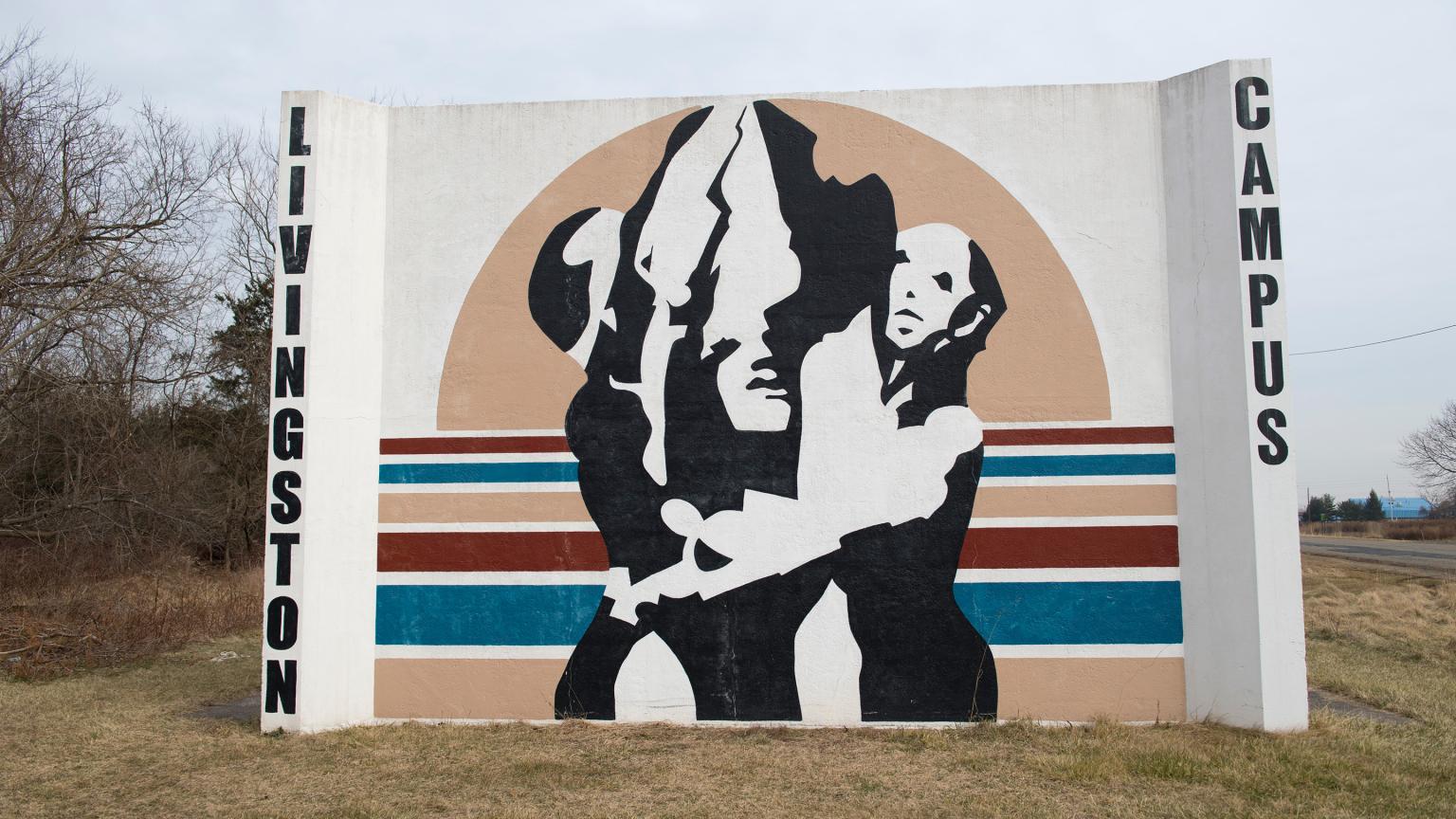- Admissions and Tuition
-
Visits and Tours
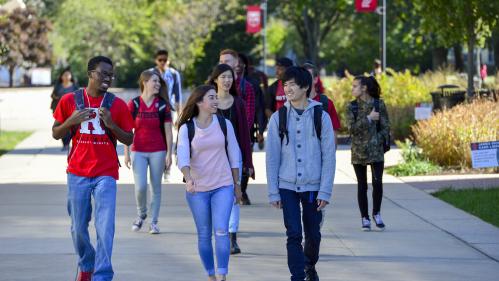
Visits and Tours
Discover the Rutgers University–New Brunswick campus for yourself by taking one or more of our fun and informative campus tours.
Take a Look Around
Exploring the Rutgers–New Brunswick experience will be time well-spent, however it works best for you: an in-person visit, virtual tour, info session, or webinar.

Tour Rutgers–New Brunswick Schools
Unlock boundless opportunities for personal growth as you begin an extraordinary journey of self-discovery and make meaningful connections.
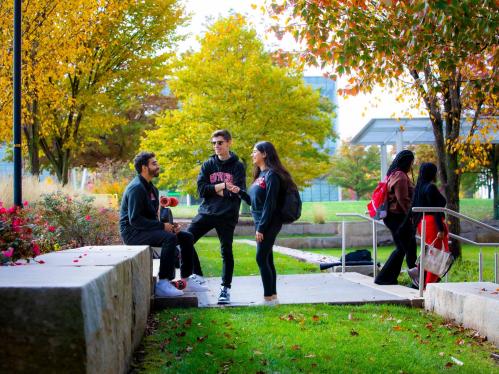
Visitor Center
The Rutgers–New Brunswick Visitor Center is a 12,000-square-foot facility located on Busch Campus. It’s the starting point for all campus tours and serves as an official New Jersey Visitor Information Center. Here you can also discover Rutgers’ history and many contributions to New Jersey, the United States, and the world.
For more information, please email Undergraduate Admissions.
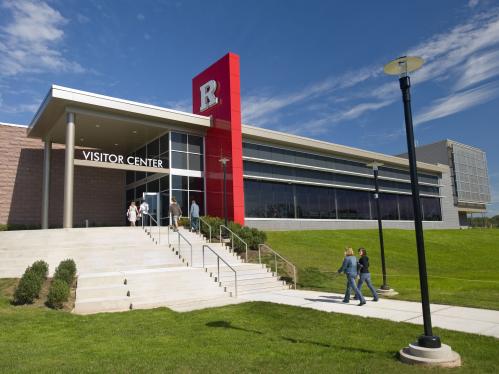
Busch Campus Sculpture Tour
Busch Campus is notable for its math- and science-based disciplines and its many athletic venues. The sculpture here is mostly abstract, which helps convey the campus’s energized, future-oriented persona.
Chichen Itza Blue (1986) by Igael Tumarkin
This piece is an abstract-geometric work which was created by world-renowned artist Igael Tumarkin. Born in Dresden, Germany, he is famous for his Holocaust memorials. This piece consists of a blue handcart and a short track of rails which could be alluding to the cattle cars used to transport prisoners to concentration camps. This piece is located between the Busch Dining Hall and Biomedical Engineering Modular Building.
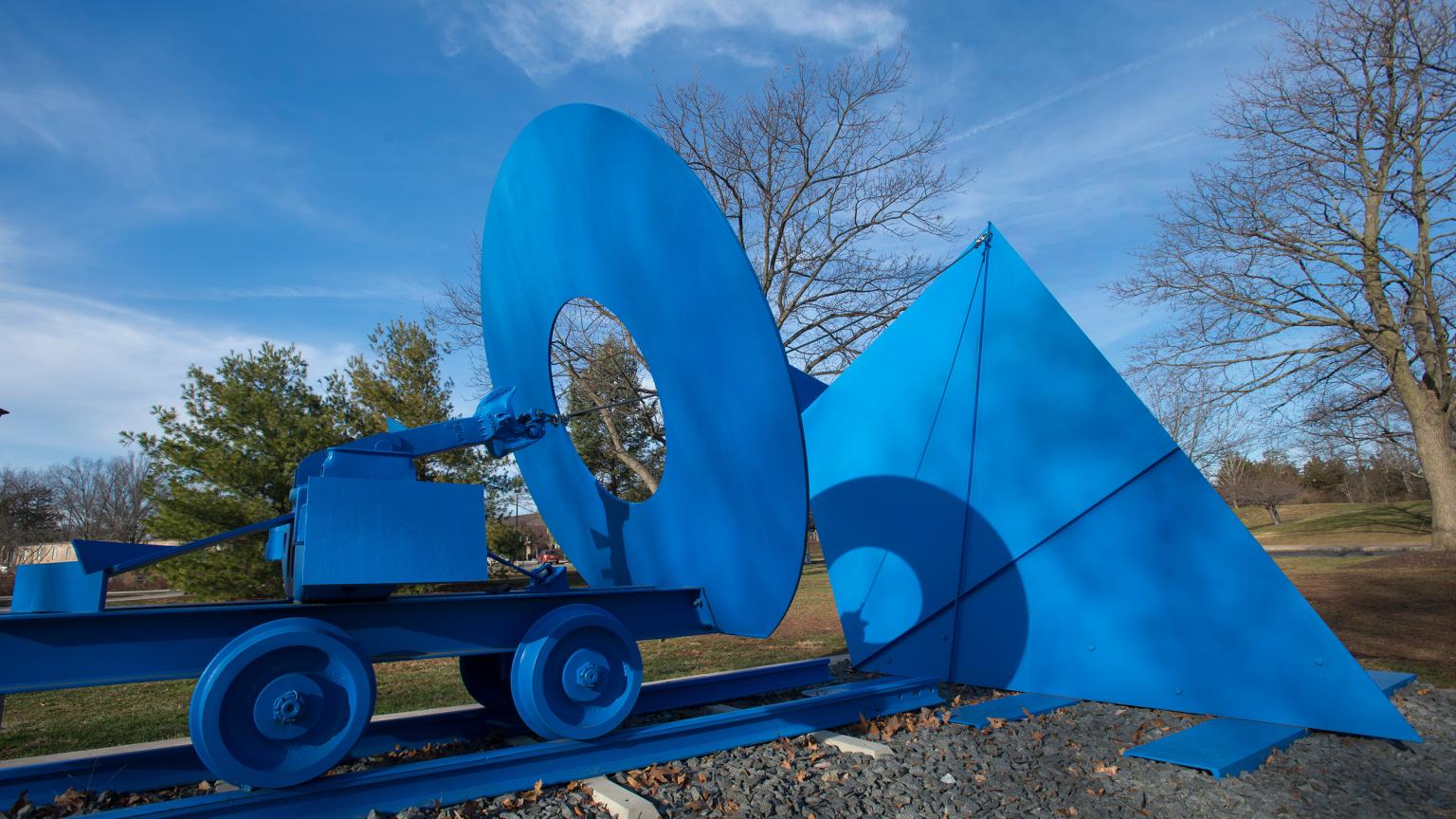
Reflections (1982) by Reuben Karol
This sculpture was a gift from the Engineering Class of 1982 and was designed by Reuben Karol, a former professor at Rutgers. This sculpture depicts an abstract female figure, sitting on top of a makeshift seat of oversized books. The pose in which she is sitting holds a deep connection to the university setting. This piece is located outside the School of Engineering and beside the Fiber Optic Materials Research Building.
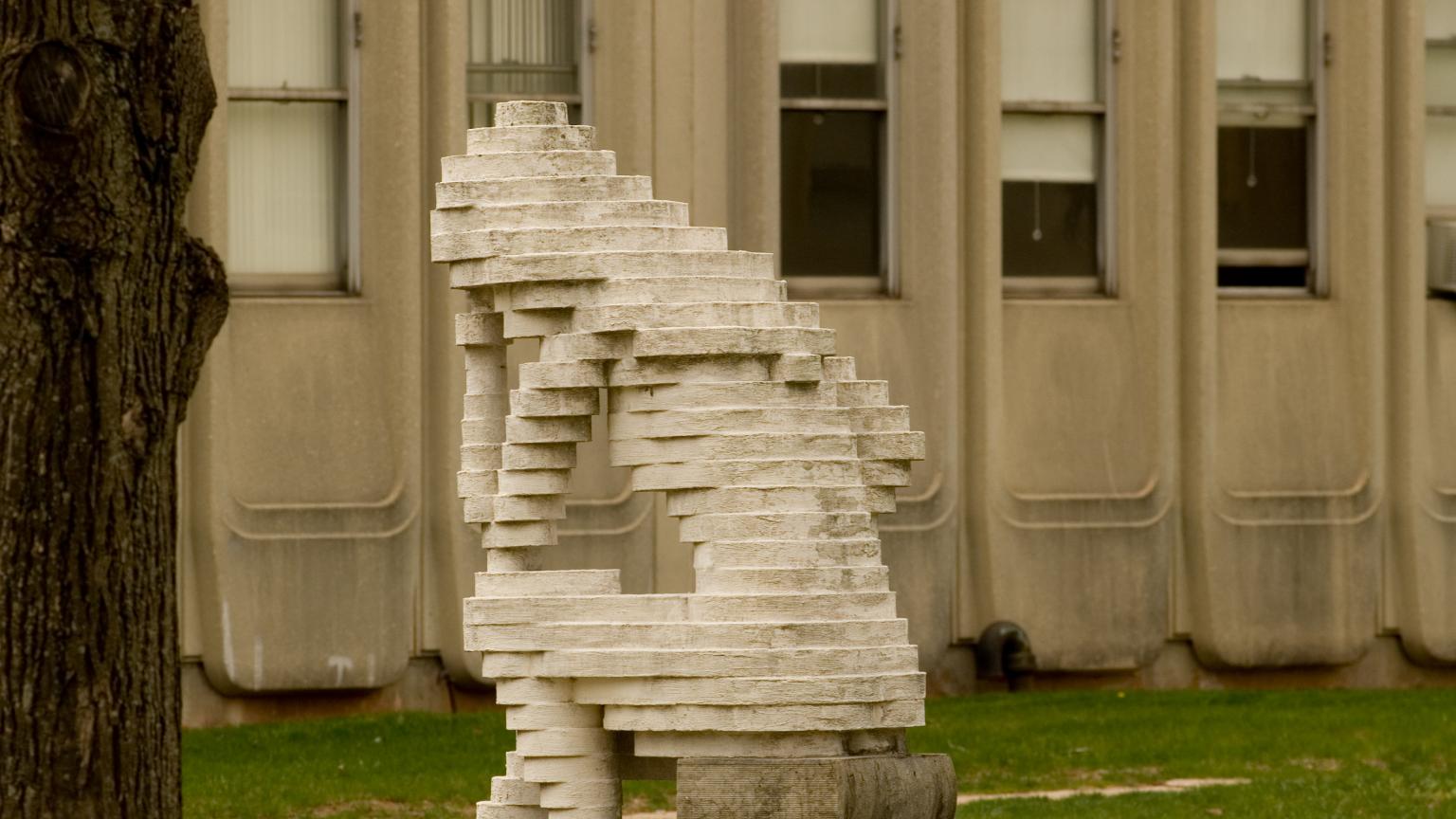
Split and Twisted (1980) by Paul Sisko
Located outside the Science & Engineering Resource Center, this piece is an outline of a red, large steel rectangle that has been split on one side and twisted outwards, breaking the two dimensional plane this shape would have had. This work is commonly seen in Paul Sisko’s “Fractured” series where artists are manipulating simple and solid geometric shapes to create new and unique visual effects.
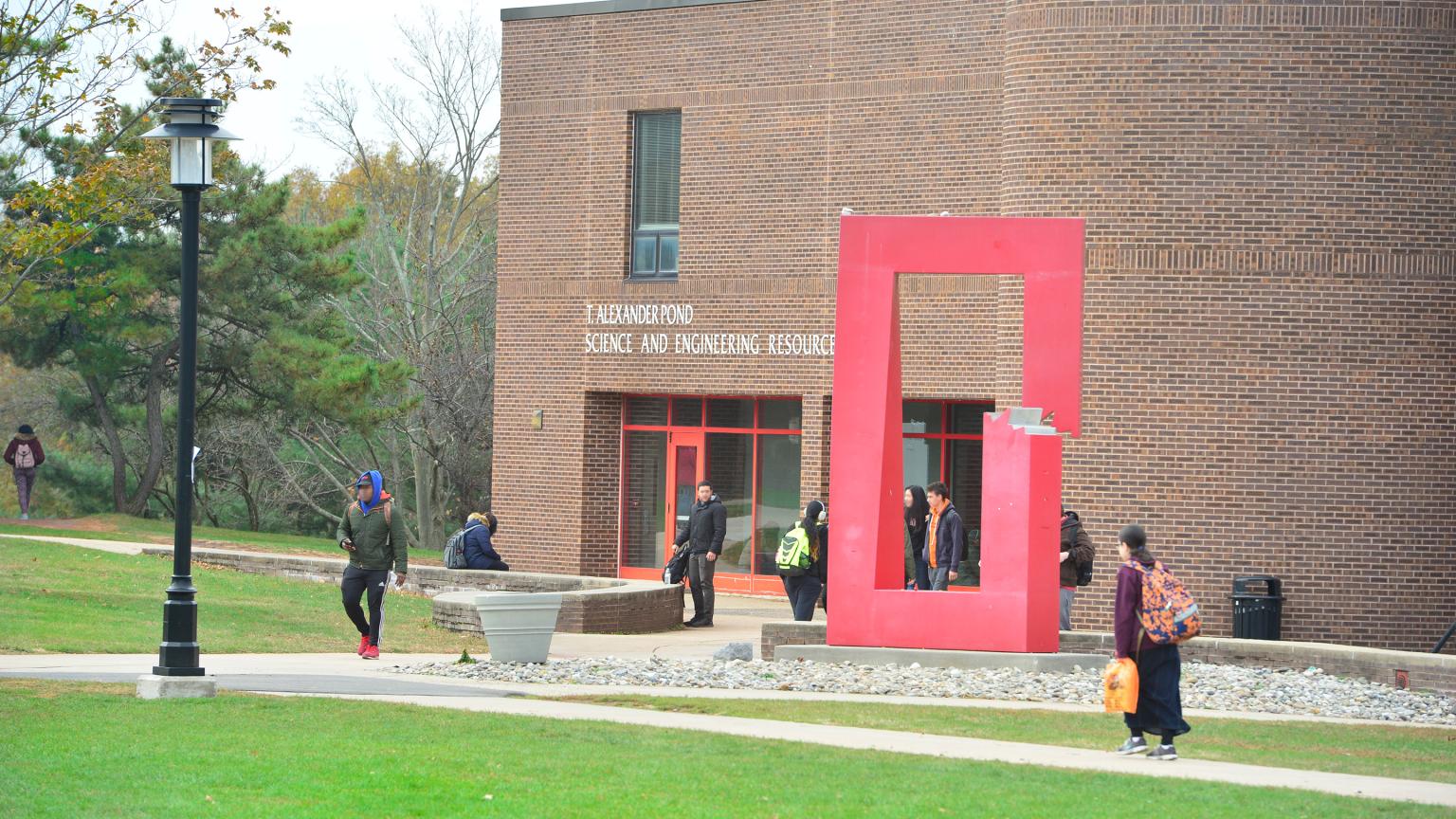
Signal (2009) by Ralph Helmick
In this piece, Ralph Hemick was aiming to create a sculpture that would complement the architecture it surrounds. This sculpture’s title is a reference to the “signal-to-noise ratio” engineering term. The artist chose to suggest a human form in motion, without creating a statue that actually moves. This work is located outside the Biomedical Engineering building, surrounding it, are the Weeks Hall of Engineering and McLaren Center for Ceramic Research.
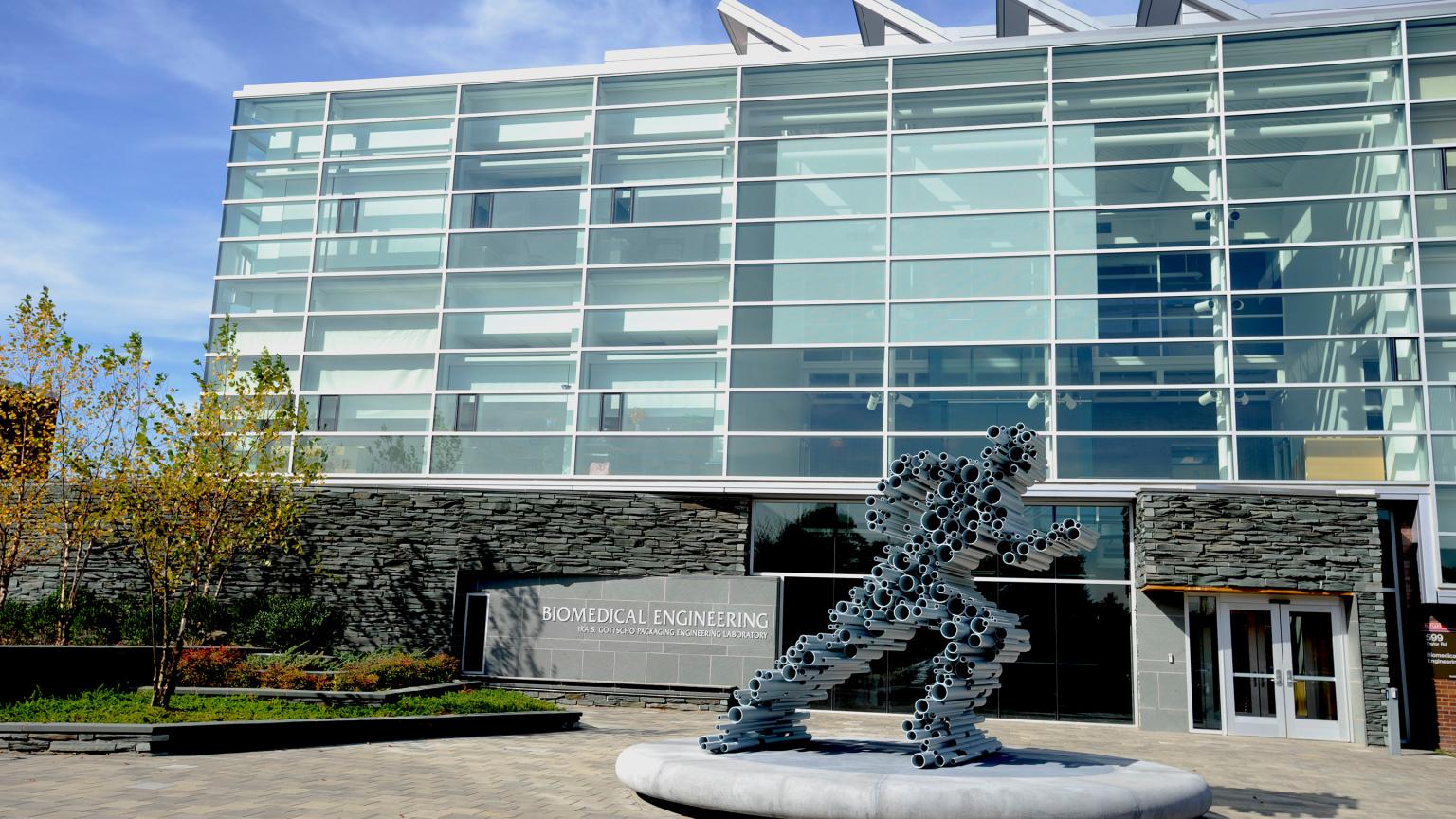
The PhD Molecule (2017), Larry Kirkland
This structure, located in front of the Chemistry and Chemical Biology Building is a large stainless-steel model of a caffeine molecule which balances on a black granite base with chemistry symbols. This piece by Larry Kirkland is an homage to the late-night brainstorming, meticulous experimentation, and endless cups of coffee that fuel groundbreaking research.
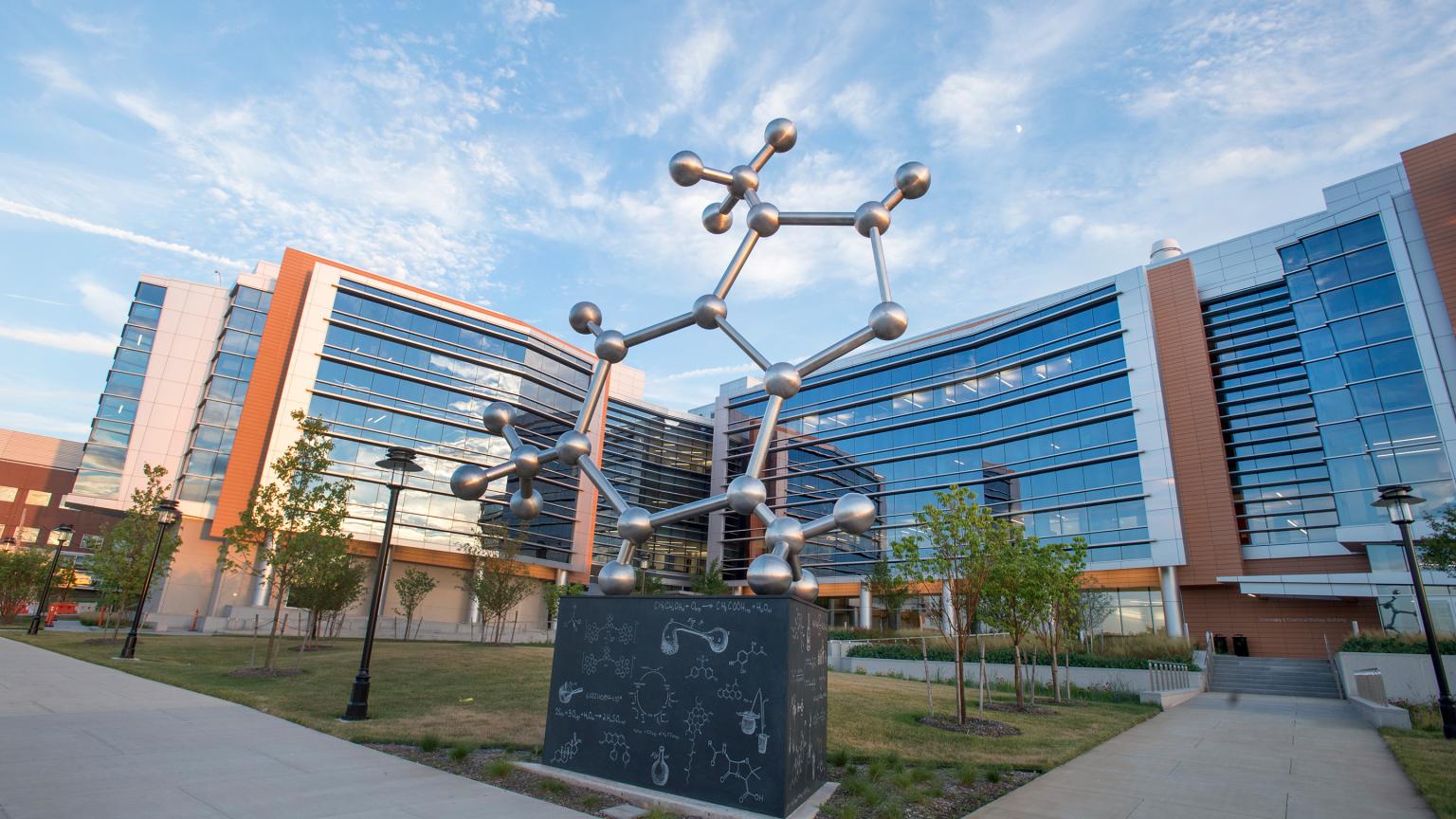
Life Forms (2005) by Michele Oka Doner
This piece by Michele Oka Doner was commissioned under the New Jersey Public Buildings Arts Inclusion Act of 1978. This piece is made using the medium which incorporates bronze figures embedded in gray terrazzo, forming the main floor of the Life Sciences Building. There are microorganisms and microorganisms rescaled and integrated into a harmonious creation.
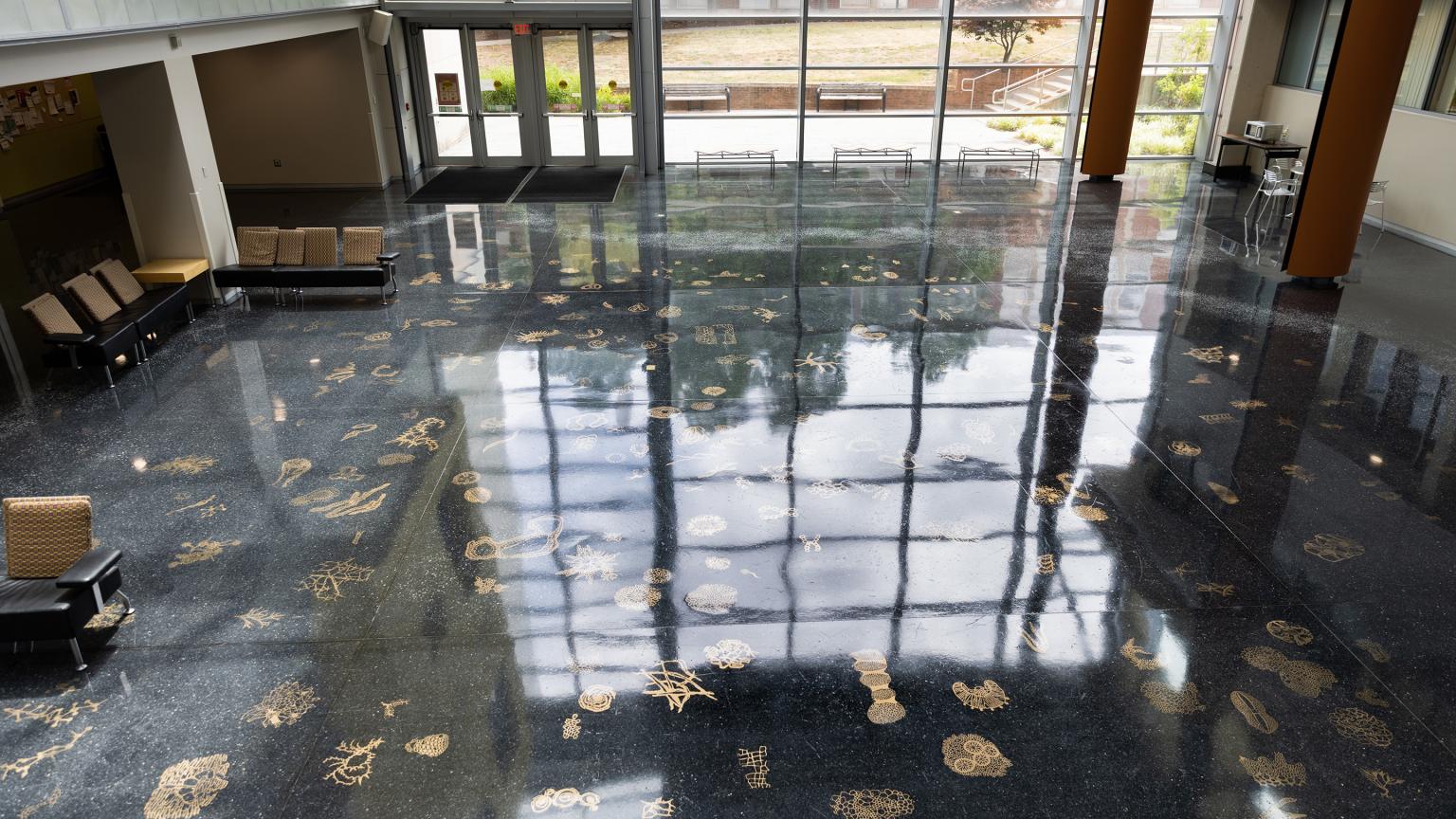
Untitled & Untitled (1993) by Patrick Strzelec
These sculptures were installed by Rutgers under the New Jersey Public Buildings Arts Inclusion Act of 1978. Strezelec created the southern stainless steel sculpture as two funnels connected with a curved pipe. The sculpture invites passersby to converse with each other by speaking into the two opposing funnel ends. This activity produces an auditory effect that creates a sensory association with the Psychology Building. This piece is located on the southern and northern sides of the Psychology building.
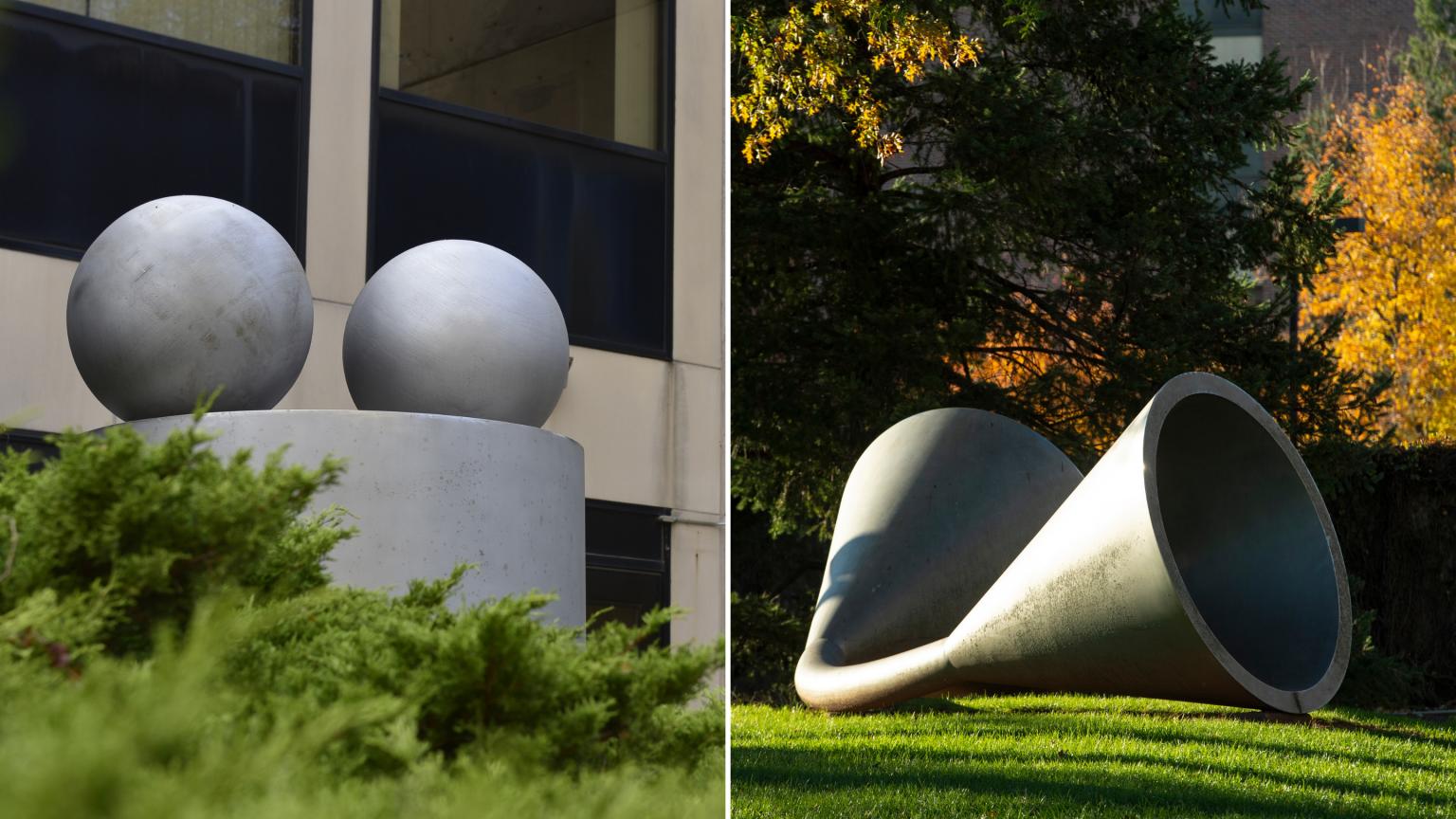
Quaternion I & II (1992) by Livio Saganic
These structures are located outside the Environmental and Occupational Health Sciences Institute building. The term “Quaternion” refers to a group of four members. In Quaternion I, four vertical stripes composed of panels of Vermont gray slate and Vermont blue slate alternate in color. Four abstract figures, each adhering to its matching slate color, project from the previously two-dimensional wall to create a strong sense of verticality. Quaternion II contains four major pieces that create the abstract sculpture, carved out of northern Québec Province granite and alluding to the meaning of the name “Quaternion.”
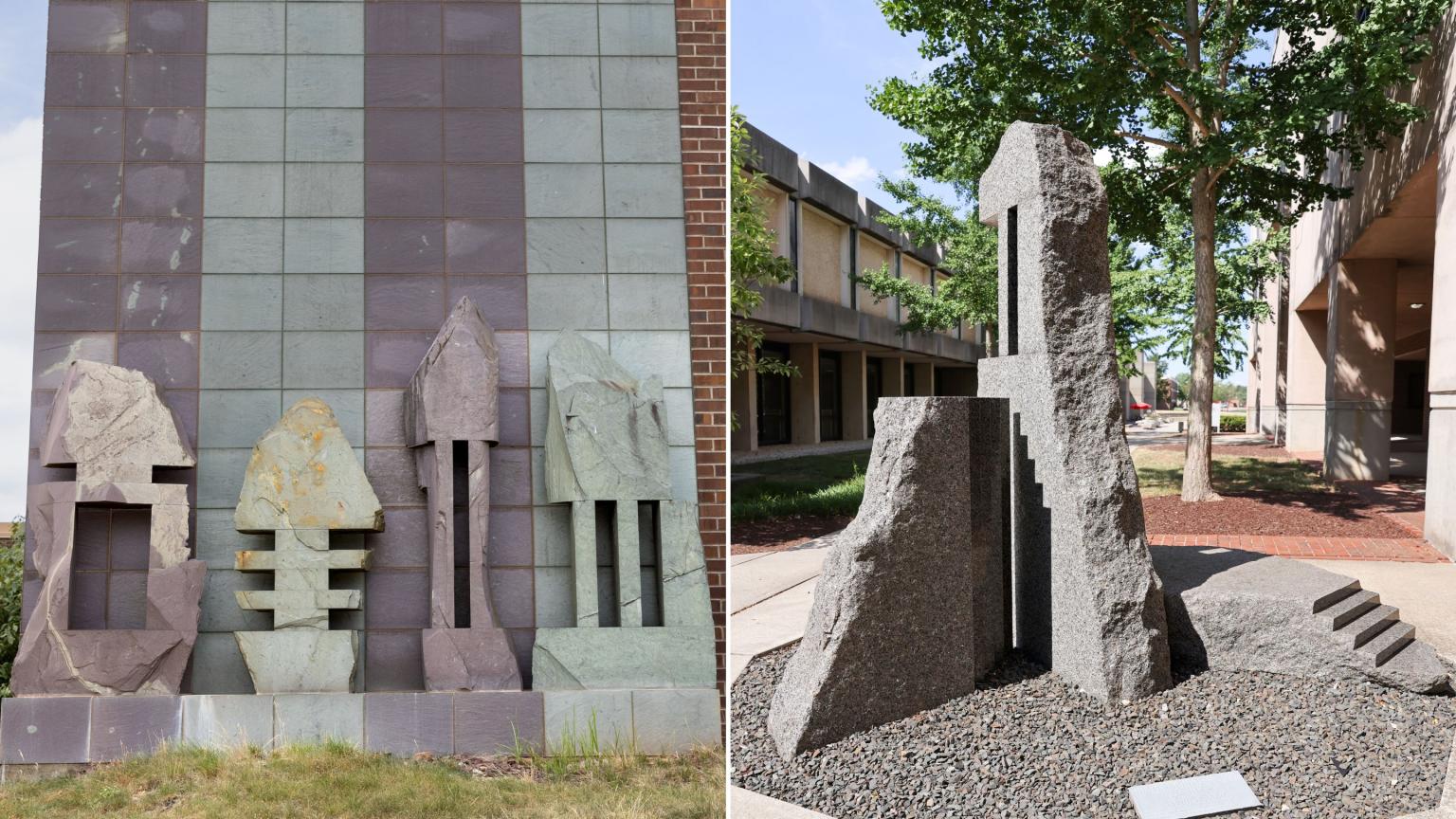
Synergy (2013) by Julian Voss-Andreae
This piece, Synergy, made by Julian-Voss Andreae is standing at an impressive 19 feet made with colored sheet glass and stainless steel. This sculpture of a collagen molecule which is the human body’s most abundant protein, is an allusion to the center’s interdisciplinary research. This piece is best seen during the day as light passes through it. During the evening it is illuminated with a beacon.
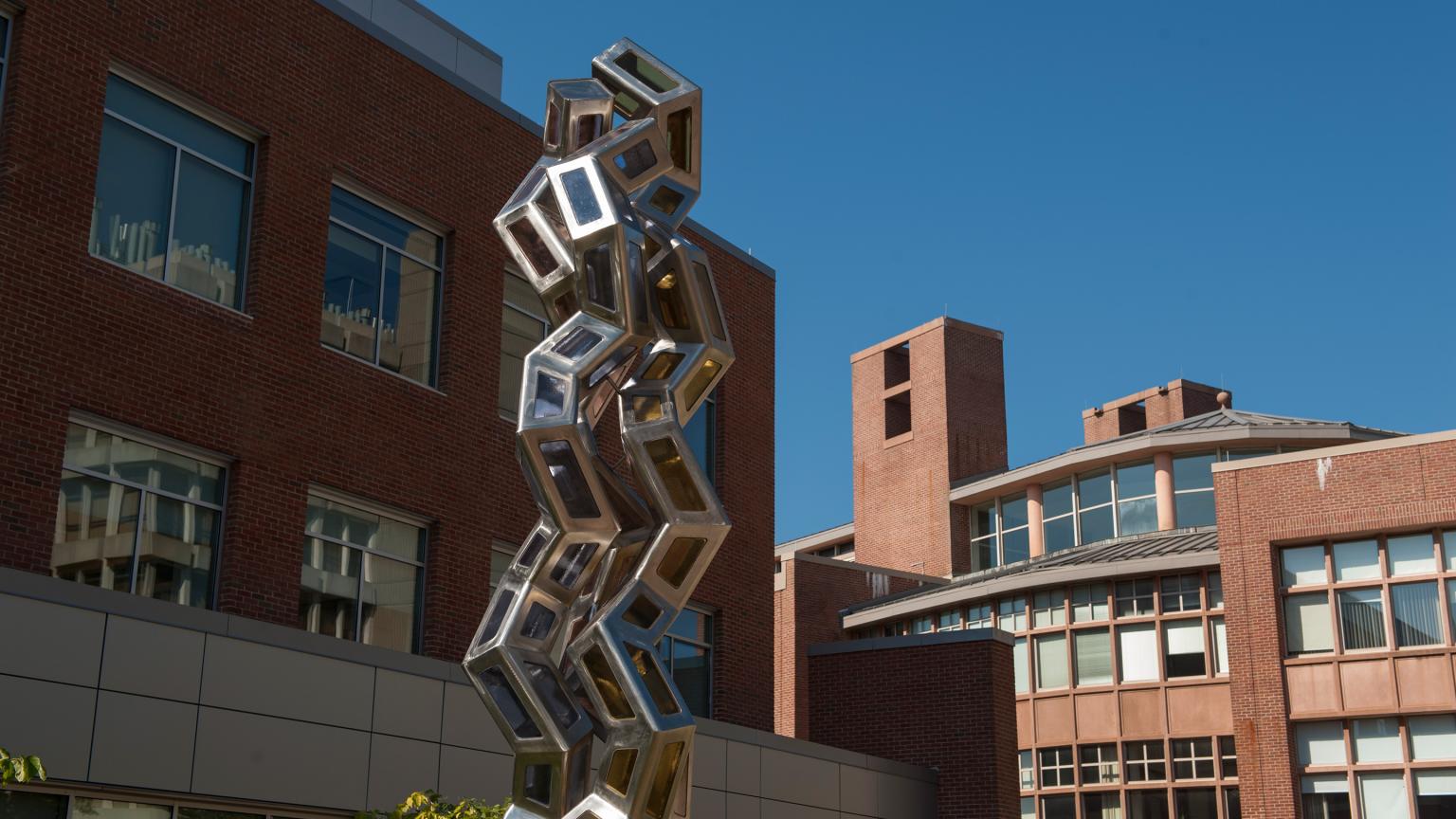
Hippocrates (1973) by Costos N. Georgakas
This statue of Hippocrates is located at the entrance of the Research Tower/Kessler Teaching Laboratories of Robert Wood Johnson Medical School. This particular statue was donated by Mr. and Mrs. Peter Sideris in 1973. As Hippocrates is referred to as the “father of modern medicine”, the Hippocratic Oath is inscribed on a plaque at the base of the statue.
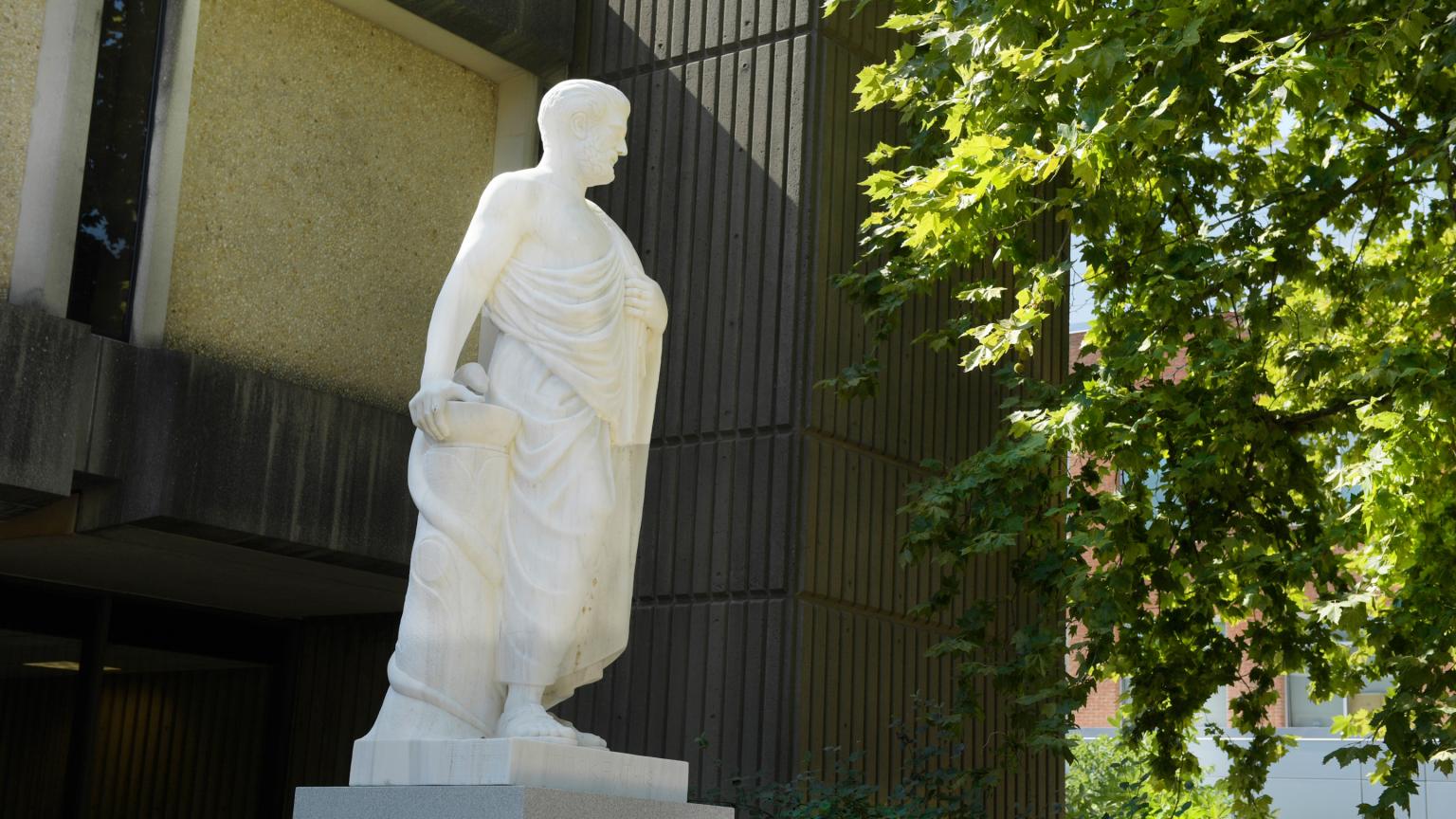
Barcelona (2002) by Toshiko Takaezu
This piece, located near the entrance of Robert Wood Johnson Medical School (RWJMS) is a bronze bell which is supported on a wooden framework and is modeled on a traditional Japanese temple gateway. This piece got its name from when the artist was traveling and heard the sounds of a church bell from her hotel.
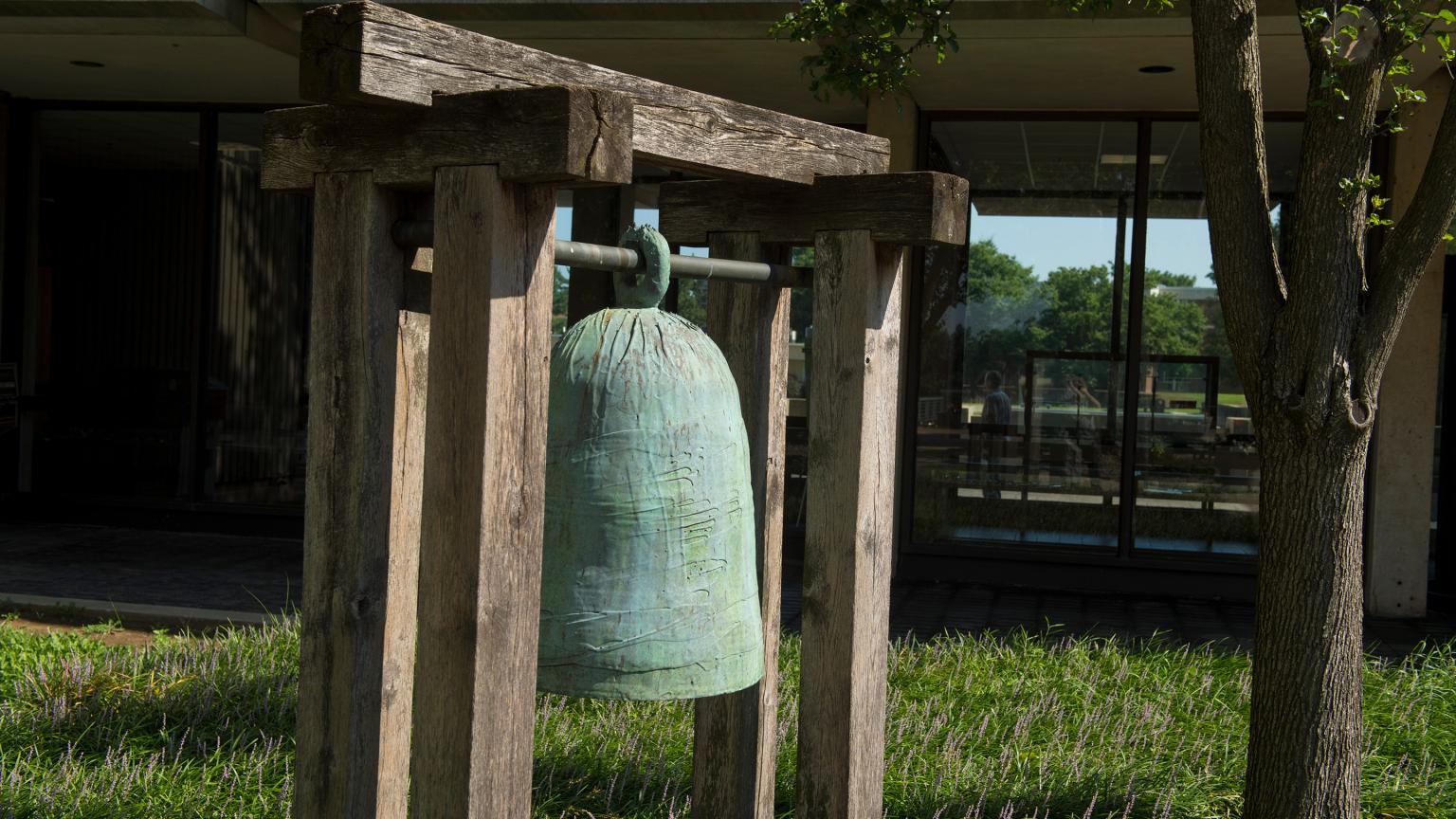
Chiron (1983) by John L. Goodyear
Outside the Robert Wood Johnson Medical School (RWJMS) there are dark square pavers along light ones, these squares create an image of Chiron, a centaur in Greek mythology. Chiron is typically renowned as “the wounded healer” and a teacher skilled in archery and medical arts.
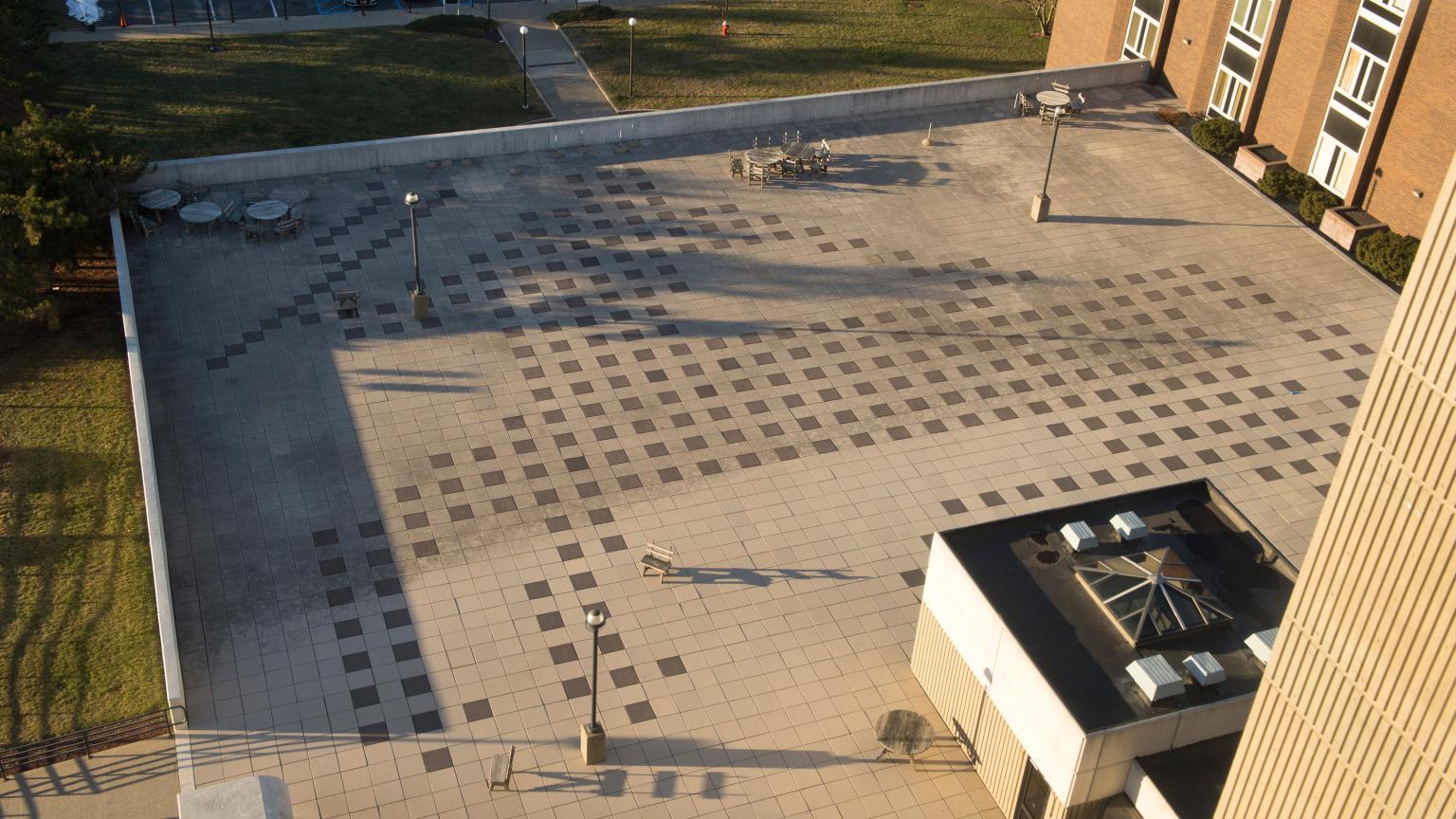
Neither Whales nor Turtles (1990) by Jene Highstein
This piece, too small to represent whales and too big to depict turtles are two rounded mounds of painted ferroconcrete. They are shown to be rising out of the ground in the courtyard of the Center for Advanced Biotechnology and Medicine. The scale of these oblong figures is meant to be an intrusion to the viewer’s space which allows a personal interaction with the piece.
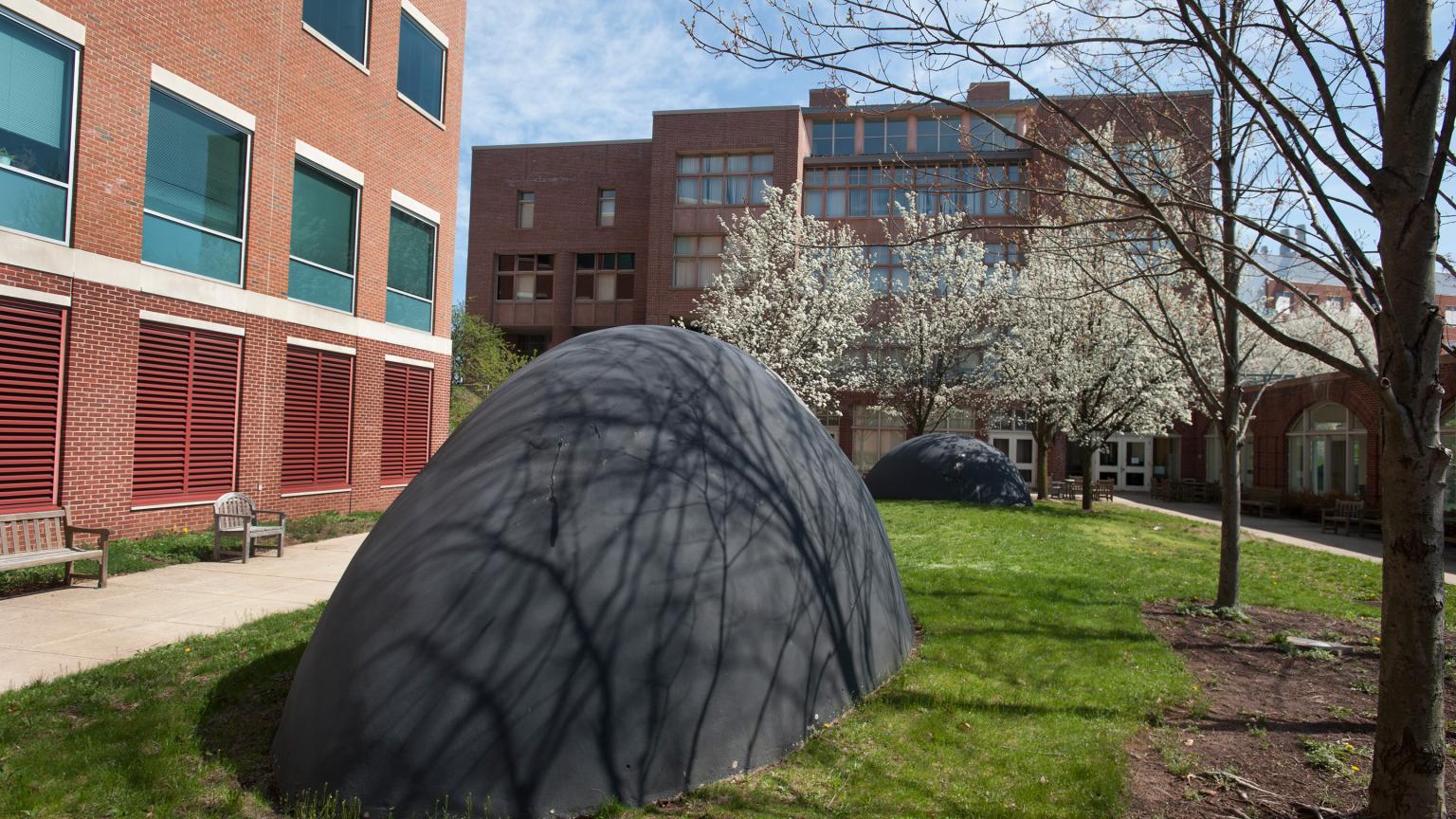
RevolUtionary Monument (2015)
Located outside the Visitor Center, as a token of friendship, this piece was given by Johnson & Johnson in honor of Rutgers’ founding. The installation comprises the word “revolutionary” in large white steel letters with the first R and the U painted scarlet and capitalized. This was unveiled in 2015 during Charter day. This monument is a play on the university tagline “Revolutionary for 250 years”.
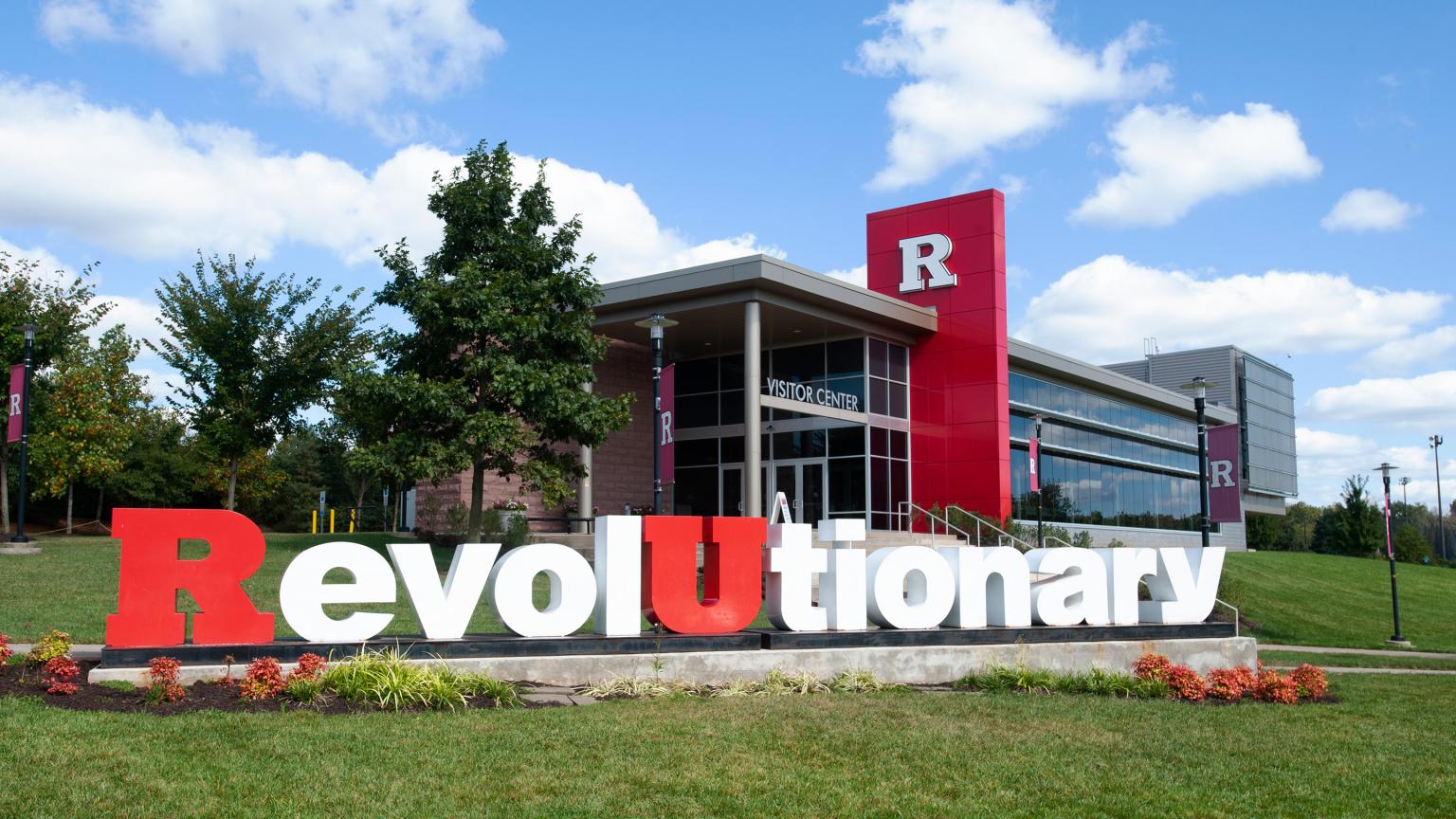
The First Football Game Monument (1997) by Thomas Jay Warren
Rutgers being the birthplace of college football, this bronze sculpture was installed as a gift from the Class of 1949. This piece made as an homage to the first game against Princeton catches the action and suspense. This sculpture depicts a Rutgers football player during an intense play running down the field. This is located outside the SHI Stadium.
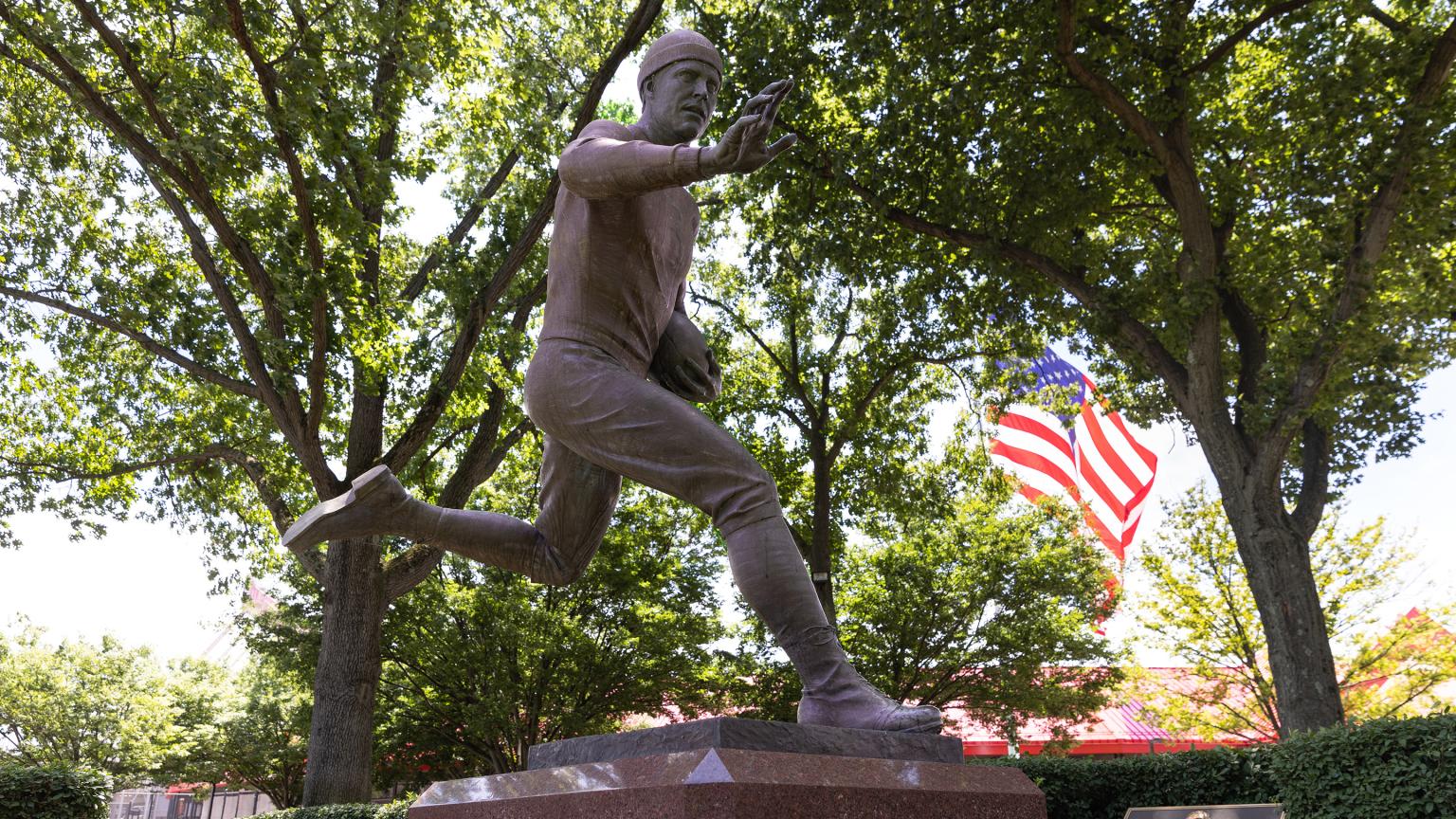
College Avenue Campus Sculpture Tour
The artwork found on College Avenue Campus preserves the presence of the university’s history in everyday student life. It also conveys the energy of life in New Brunswick, Rutgers’ home for more than 250 years.
Untitled (1993) by Mary Miss
Located by the entrance to Alexander Library there is a creation commissioned under the New Jersey Public Buildings Arts Inclusion Act of 1978. Mary Miss, the artist composed this work using elements that depict a rough map of the city of New Brunswick. This work is a self-reflection piece which connects the library and the university to the city.
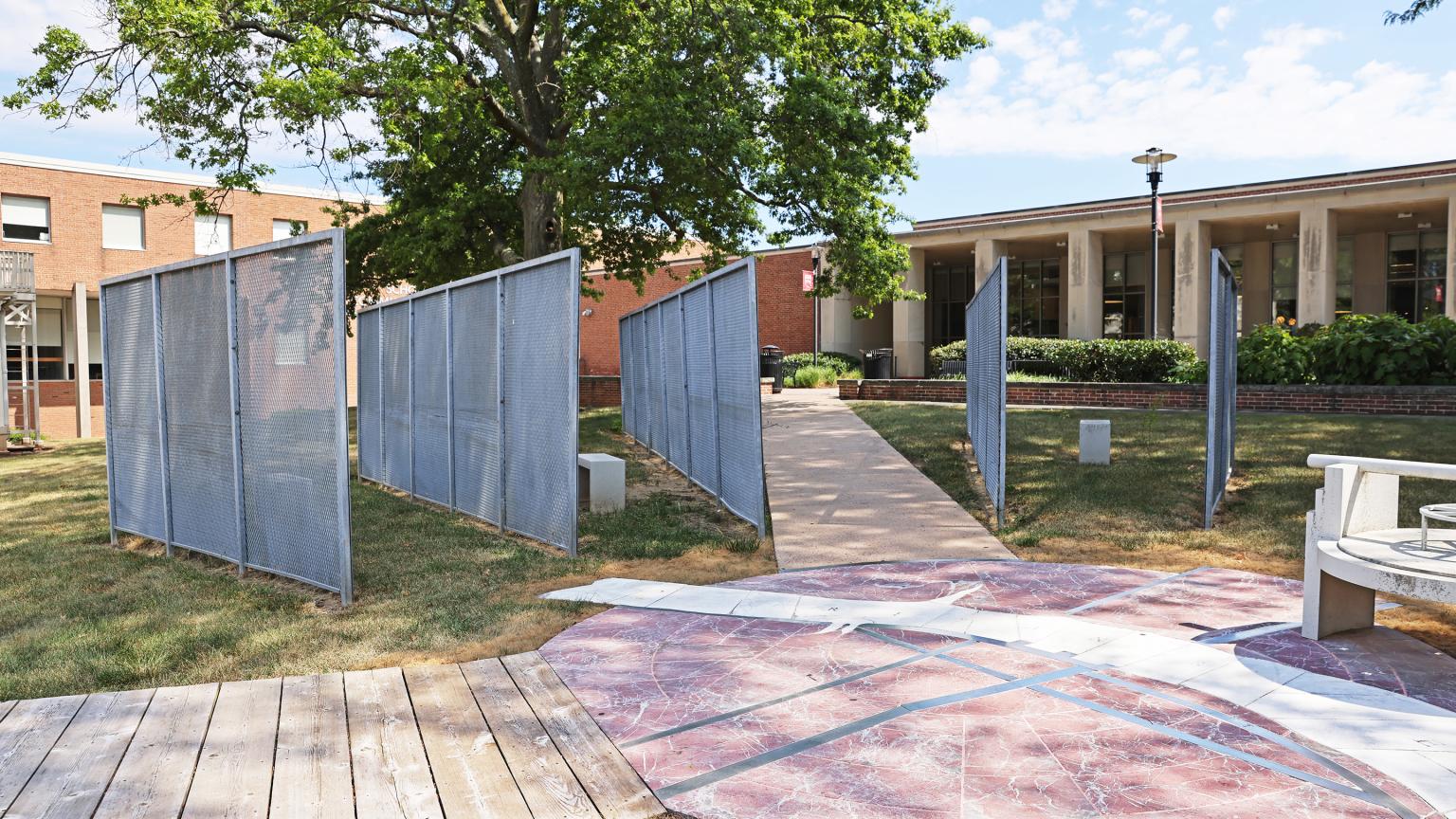
Untitled (1974) by George Kuehn
This piece abstractly constructed with concrete and steel is a sculpture created by George Kuehn who is known for works “stacked and wedged together” that “set up an internal system of forces”. This structure consists of two concrete columns at differing lengths which have been pierced by a circular steel object. This work is located outside of the School of Communication and Information.
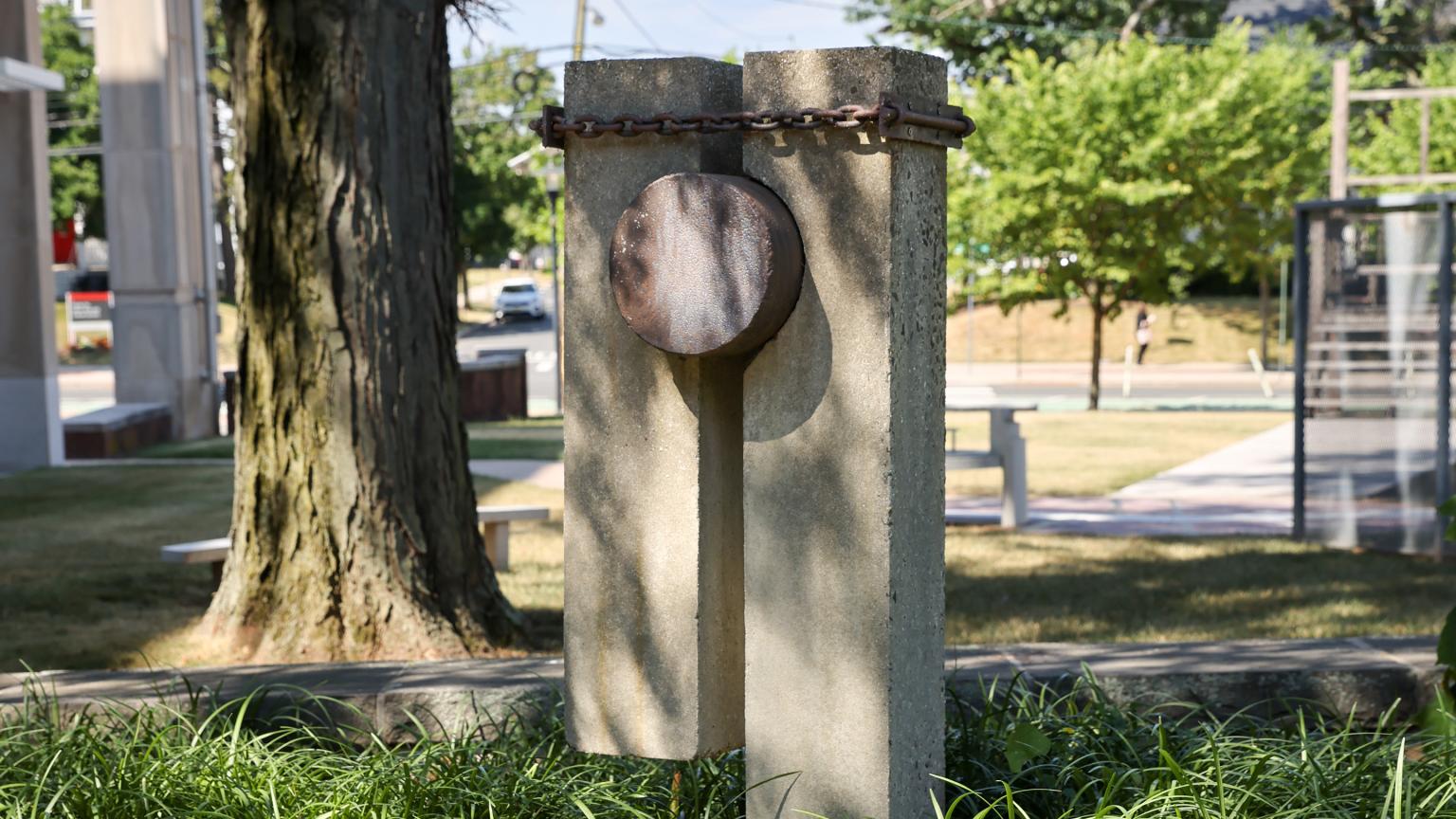
Paul Robeson Plaza (2019) by members of the Class of 1971
This structure located on Voorhees Mall near Seminary Place, the Paul Robeson Plaza honors the legacy of one of the university’s greatest graduates and invites passersby to sit in quiet reflection and draw inspiration from the remarkable life of this scholar, athlete, actor, singer, and global activist. The eight black granite panels that line one of the inner-facing walls highlight facets of Robeson’s life through etched images of Robeson and quotations from him. A central paving stone displays a dedication message from the Class of 1971.
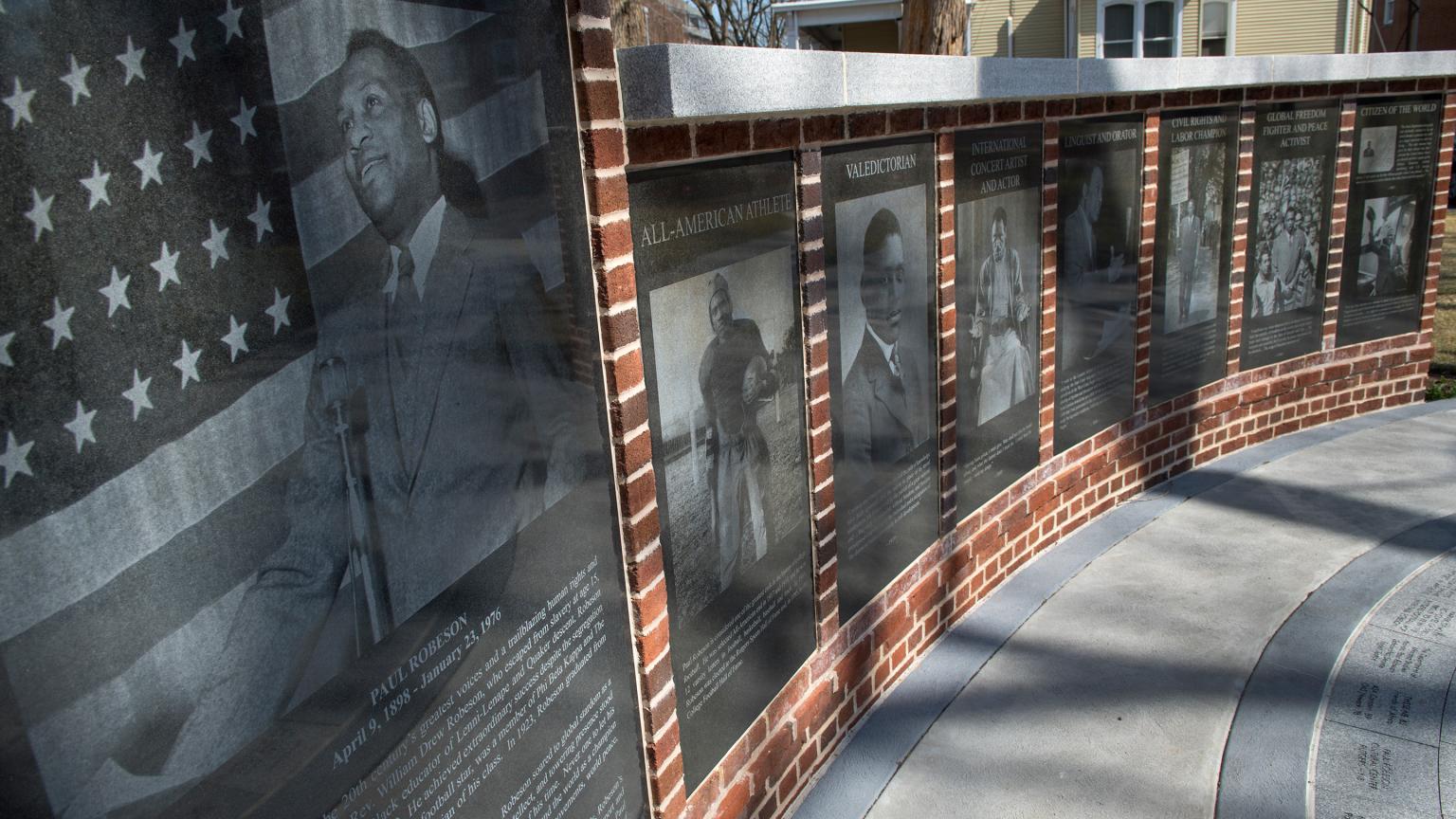
William the Silent (1928) by Toon Dupuis
Located near Van Dyck Hall, this bronze statue of William the Silent (1533-1584), Count of Nassau, Prince of Orange, and national hero of the Netherlands, was unveiled on the present Voorhees Mall on June 8, 1928, stands as an apt reminder of the university’s Dutch origins. This 2,000 pound statue was a gift of Fenton B. Turck, a prominent physician and biologist. Together with Leanor F. Loree, Class of 1877, and Rutgers trustee, Turck conspired to anonymously present the statue to the university.
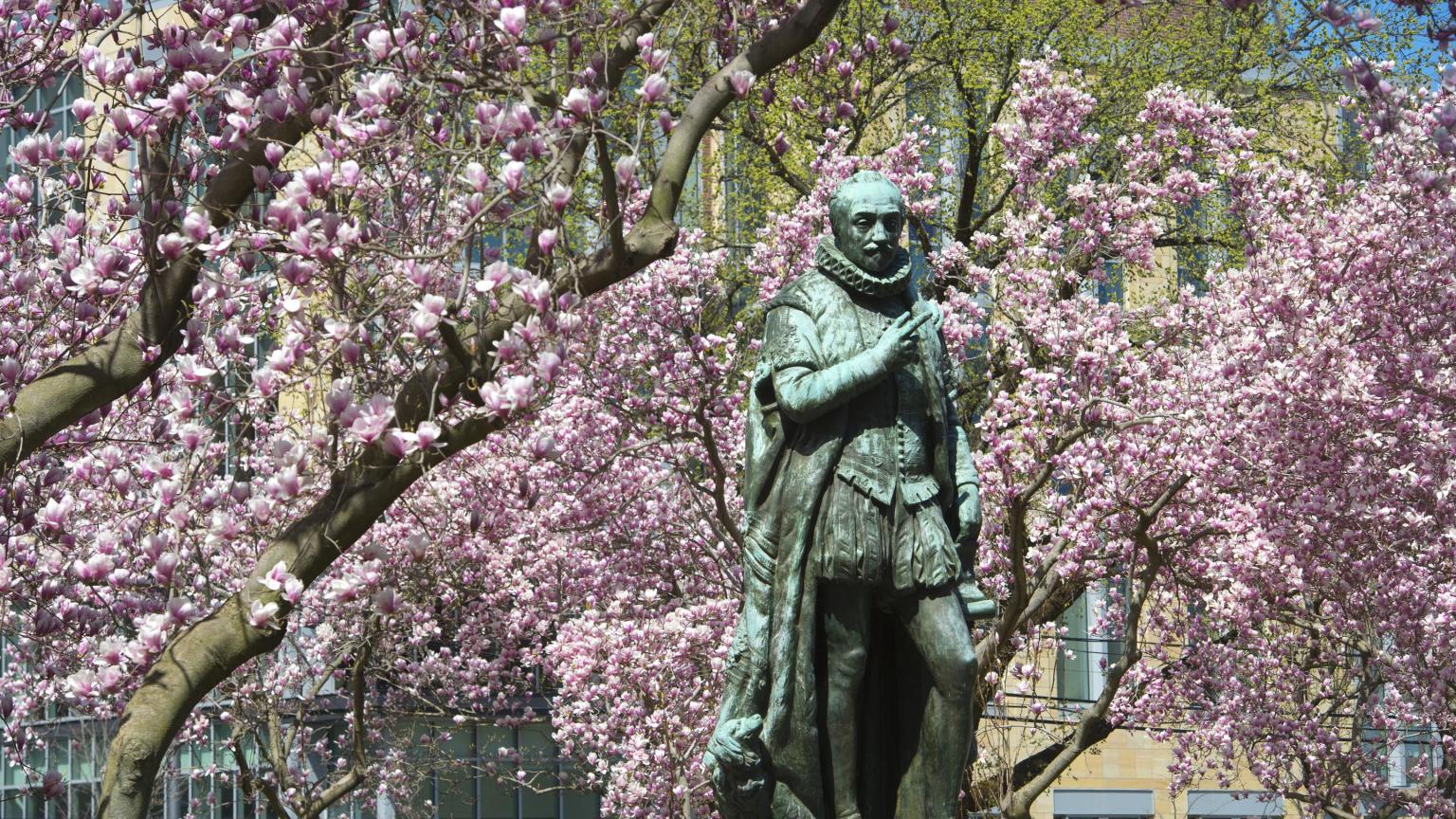
Mason Gross Memorial (1994) by Thomas Jay Warren
Located outside of Milledoler Hall, this structure was presented as a gift in honor of its 25th reunion, the Class of 1968 commissioned Thomas Jay Warren, to create the Mason Gross Memorial in 1994. The Mason Gross Memorial offers students a comfortable perch on a semicircular granite bench connected to the side of the granite-framed bronze relief bust.
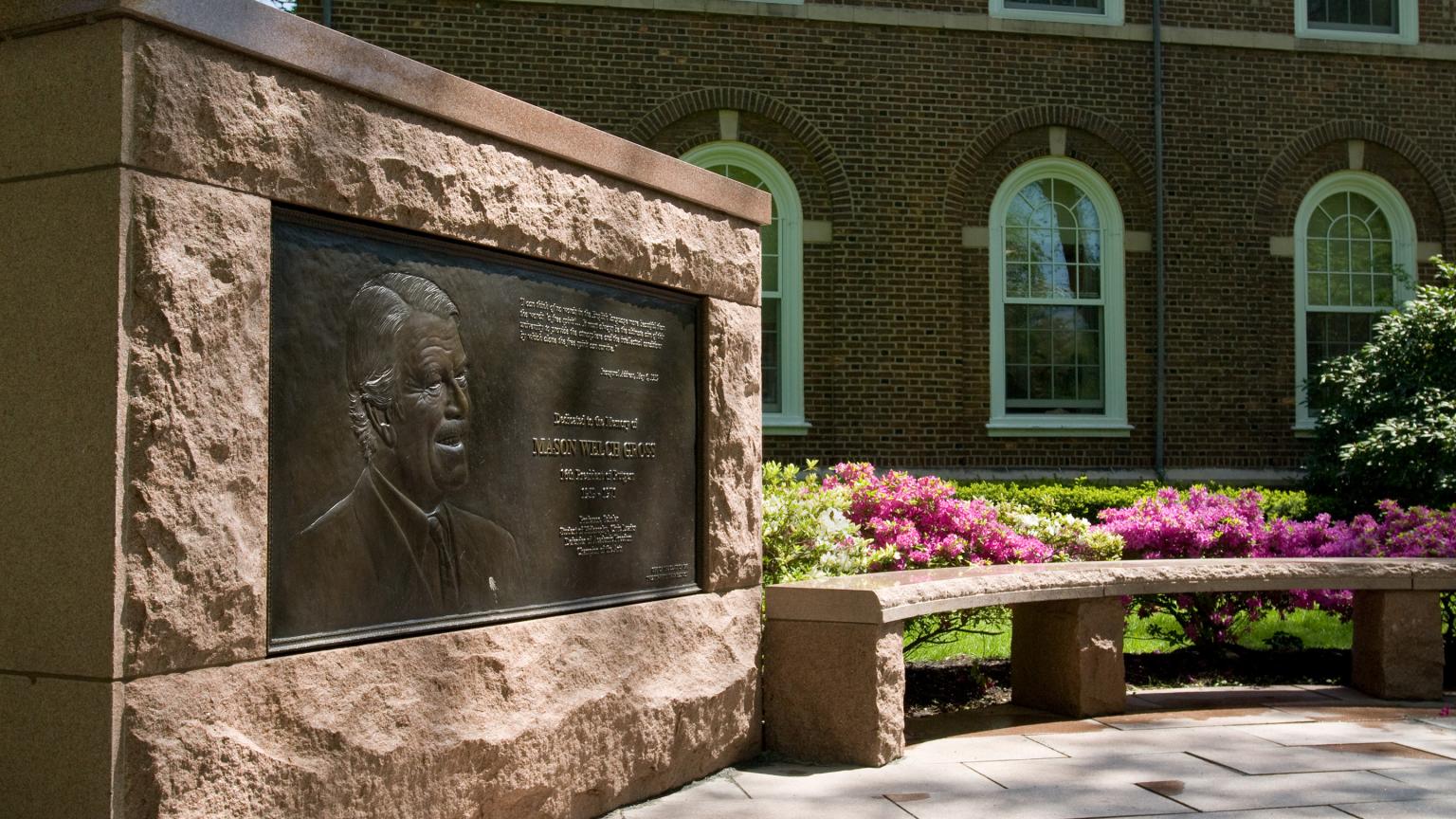
Inside Out (1982) by Buky Schwartz
This structure, previously stood outside of Voorhees Hall, near the Jane Voorhees Zimmerli Art Museum. It now stands outside of Van Dyck Hall and Scott Hall. This sculpture consists of a large block of granite, sliced into roughly even corners, then turned inside out, thus making the smooth interior cuts of the sculptures the exterior. The largest and center plaque dedicated the memorial to all those “whose lives were turned inside out by their service in World War II”. Surrounding this plaque are the names of Rutgers alumni who lost their lives during the war.
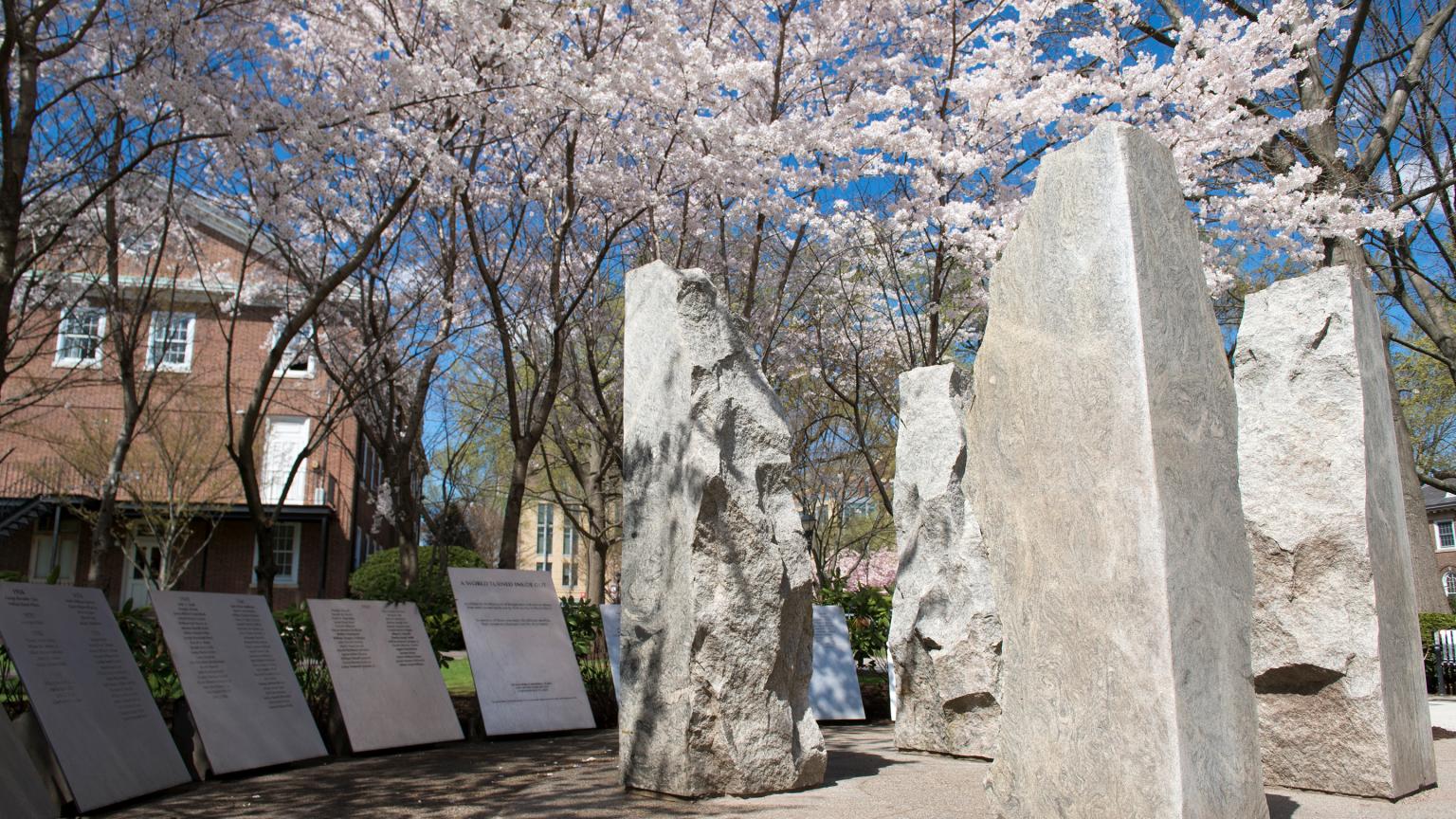
Vietnam War Memorial (1993) by R. Allan Christianson
This structure, presented by the Class of 1965, is in remembrance of the 12 Rutgers graduates who died serving in the Vietnam War and the three who are missing in action. R. Allan Christianson, an architect, designed this structure as a result of a design competition. He was able to successfully integrate the piece into its surrounding environment. This piece is located outside of Scott Hall.
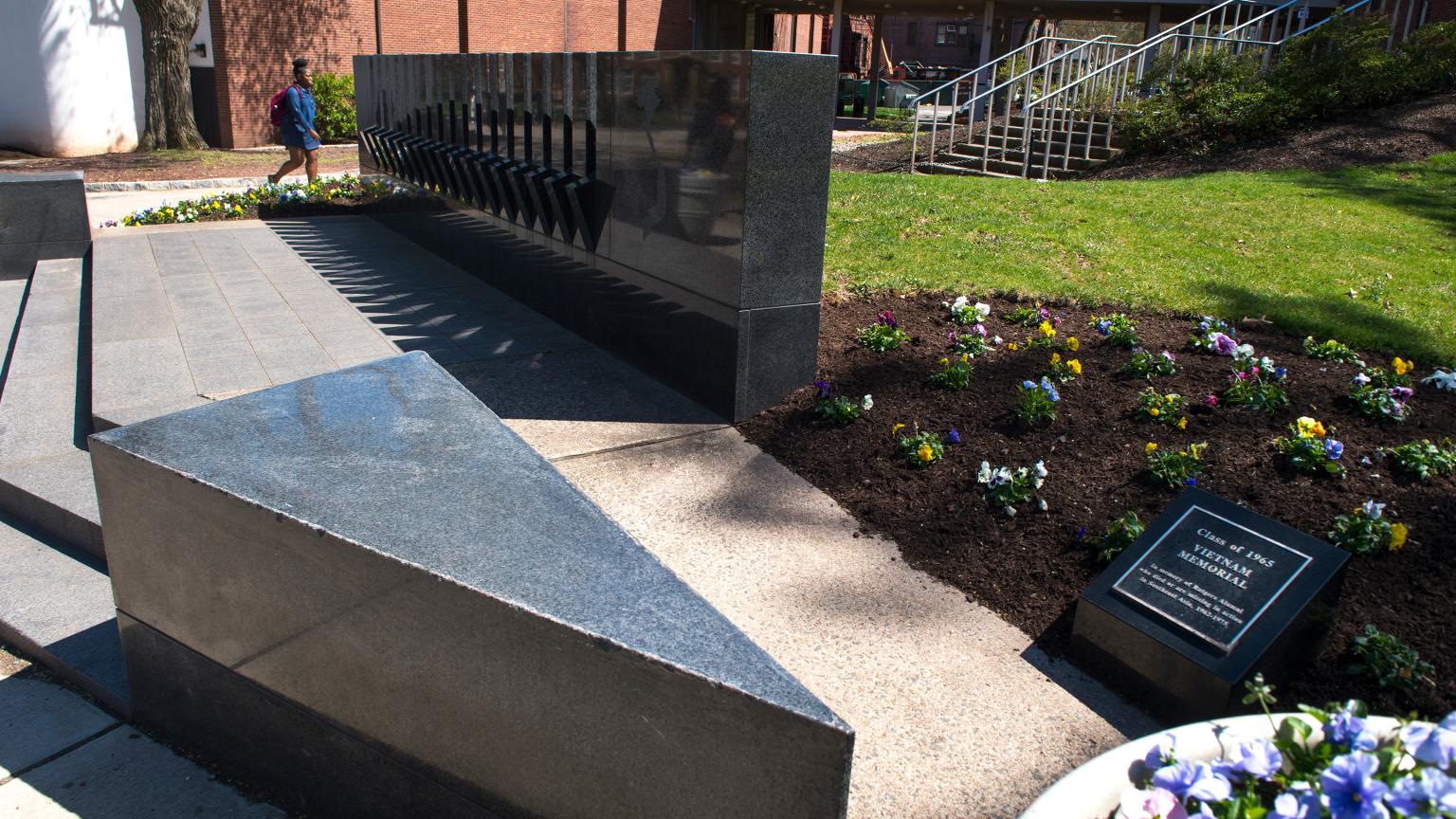
Walking Man (1988) by George Segal
This statue of a walking man can be found outside of the Jane Voorhees Zimmerli Art Museum at the corner of George and Hamilton streets. Walking Man is positioned directly in mid-stride on the pathway to the entrance of the museum. The figure expresses profound human moments; a pause that suggests reflection, indecision, or even regret in the midst of moving forward.
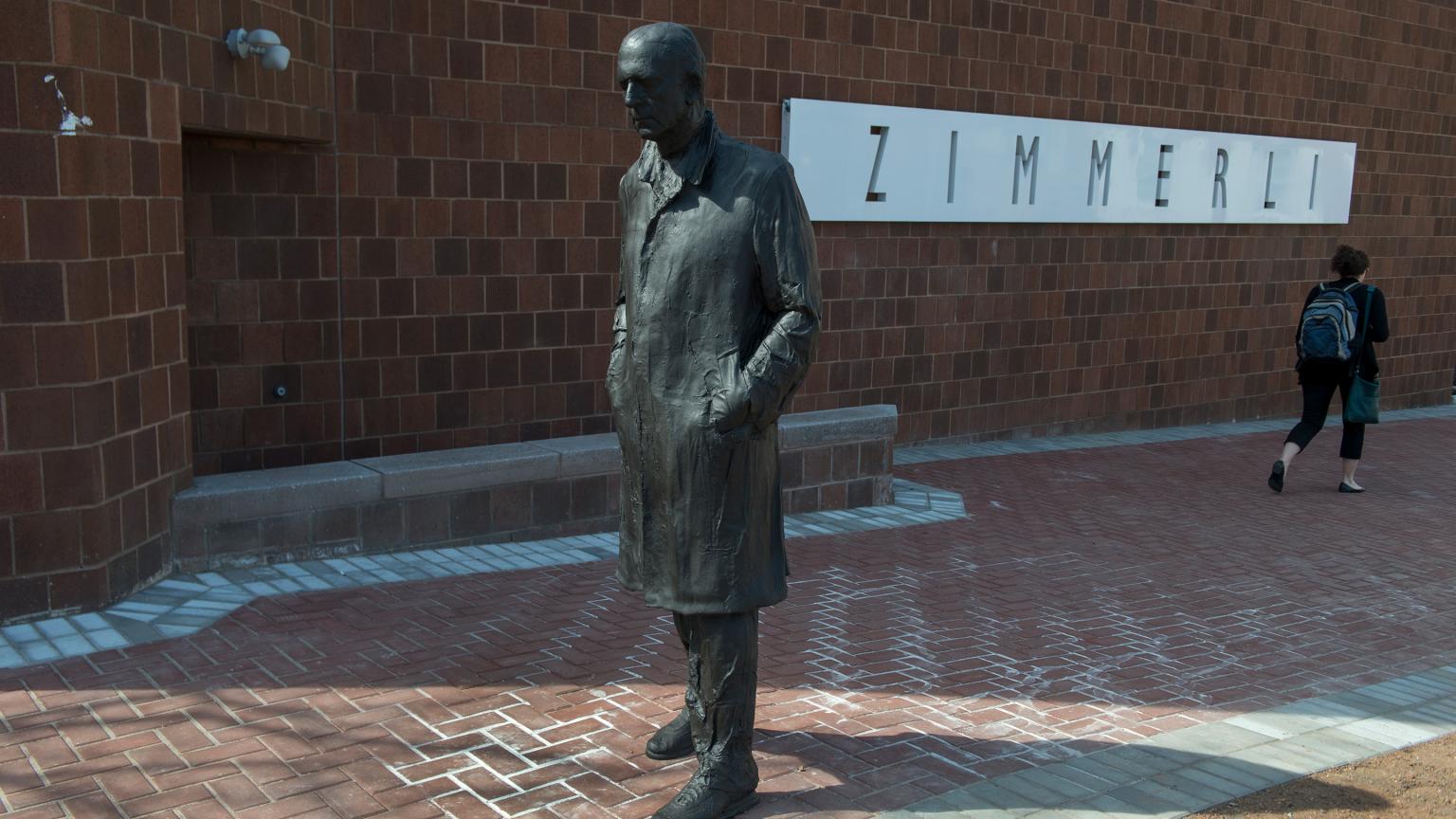
The Tuning Fork Oracle (1997) by Alice Aycock
This structure by Alice Aycock, a Douglass College graduate of 1968, uses marble, galvanized steel, aluminum and plexiglass in order to create a tipsy-turning table. This leaves the viewer vulnerable to a slight sense of disorientation. This piece is located outside Civic Square/Mason Gross/Bloustein School.
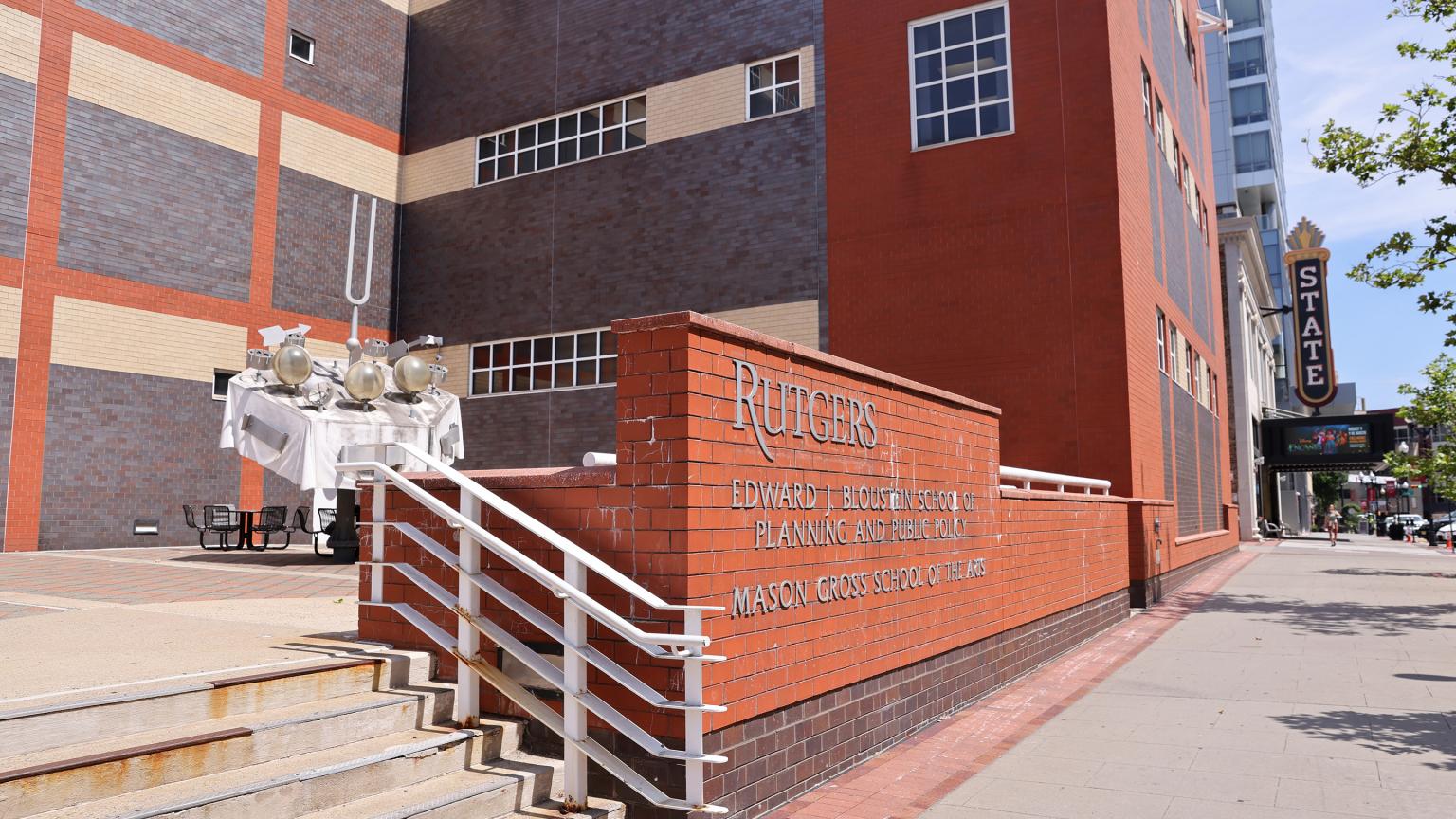
Inside Hippocrates (1994) by George Greenamyer
George Greenmayer, a finalist of the New Jersey Public Buildings Arts Inclusion Act of 1978 selection process, designed this sculpture for the front of the Robert Wood Johnson Medical School Clinical Academic Building. He created a structure consisting of figures of realistic looking people engaged in an interactive narrative.
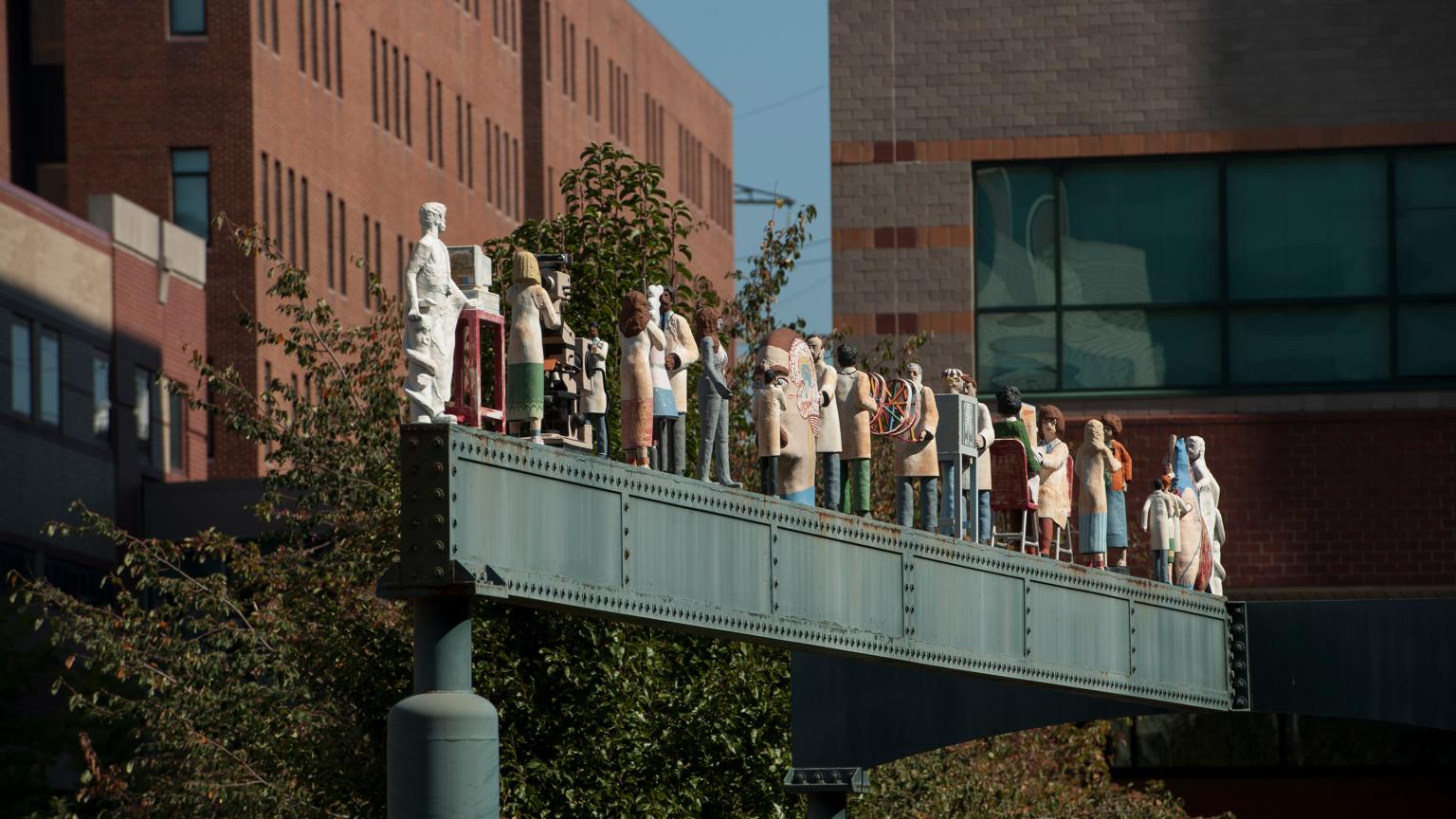
Prayer Feather (2002) by Edward M. Adams
This sculpture, donated in 2002, commissioned by the Hemophilia Association of New Jersey is located at the entrance of the Robert Wood Johnson Medical School Clinical Academic Building. Created by Edward M. Adams, this is dedicated to the lives lost to HIV/AIDS and to those who fight the disease today. This was chosen as a symbol for hope and pain as in Native American beliefs a feather refers to holding living energy and connecting us with forces greater than ourselves.
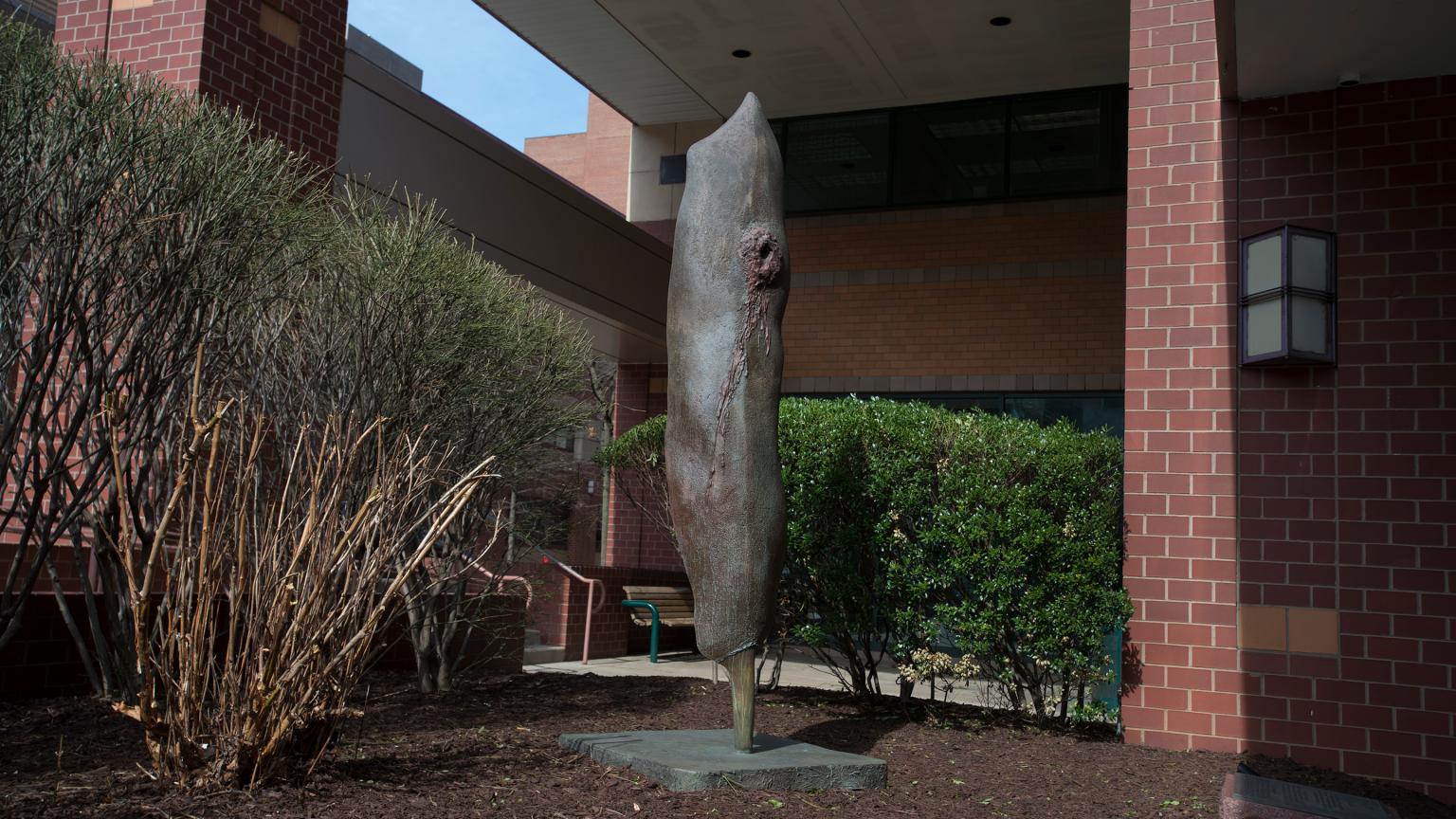
Free Fall (2003) by Elyn Zimmerman
This sculpture created by Elyn Zimmerman, under the New Jersey Public Buildings Arts Inclusion Act of 1978, was donated in 2004 and sits in front of the Rutgers Cancer Institute of New Jersey building. Much of the building’s facade consists of glass windows. Zimmerman thought a “nature-scape” would be something nice for patients sitting in the waiting room to look at.
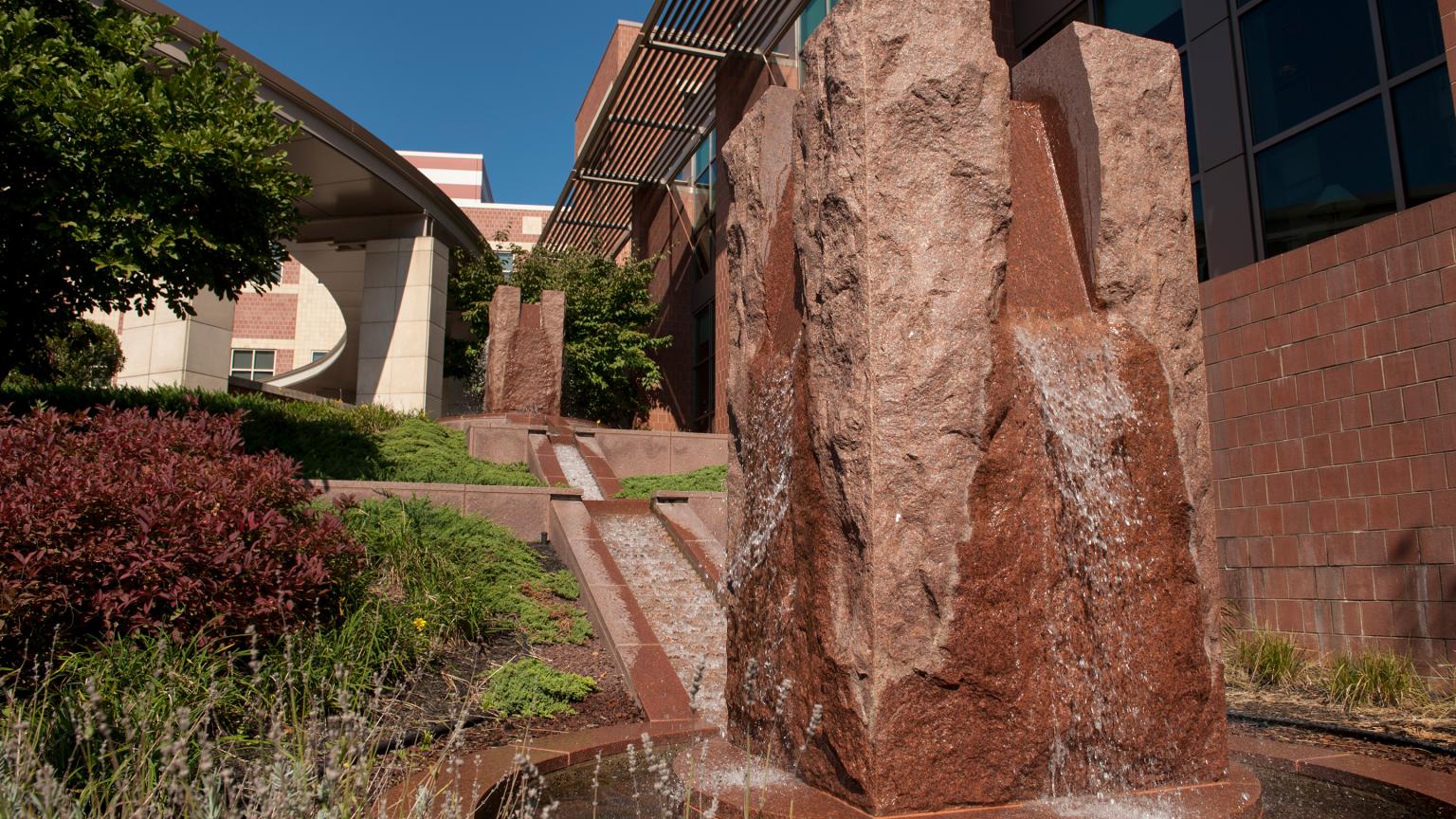
Cook/Douglass Campus Sculpture
The G.H. Cook/Douglass Campus is home to facilities for the School of Environmental and Biological Sciences, Douglass Residential College, the School of Arts and Sciences, and the Mason Gross School of the Arts. Sculptures on this campus give a nod to the natural world, women’s leadership, the arts and sciences, and the performing arts.
Chair for Looking at Manhattan Island (1983) by Michel Gerard
Located outside the Ruth Adams Building, this structure is towering above the head of the passerby and is partially hidden by an overgrowth of tree branches. This chair is facing the direction of Manhattan as a reminder to students of Rutgers’ proximity to the city.
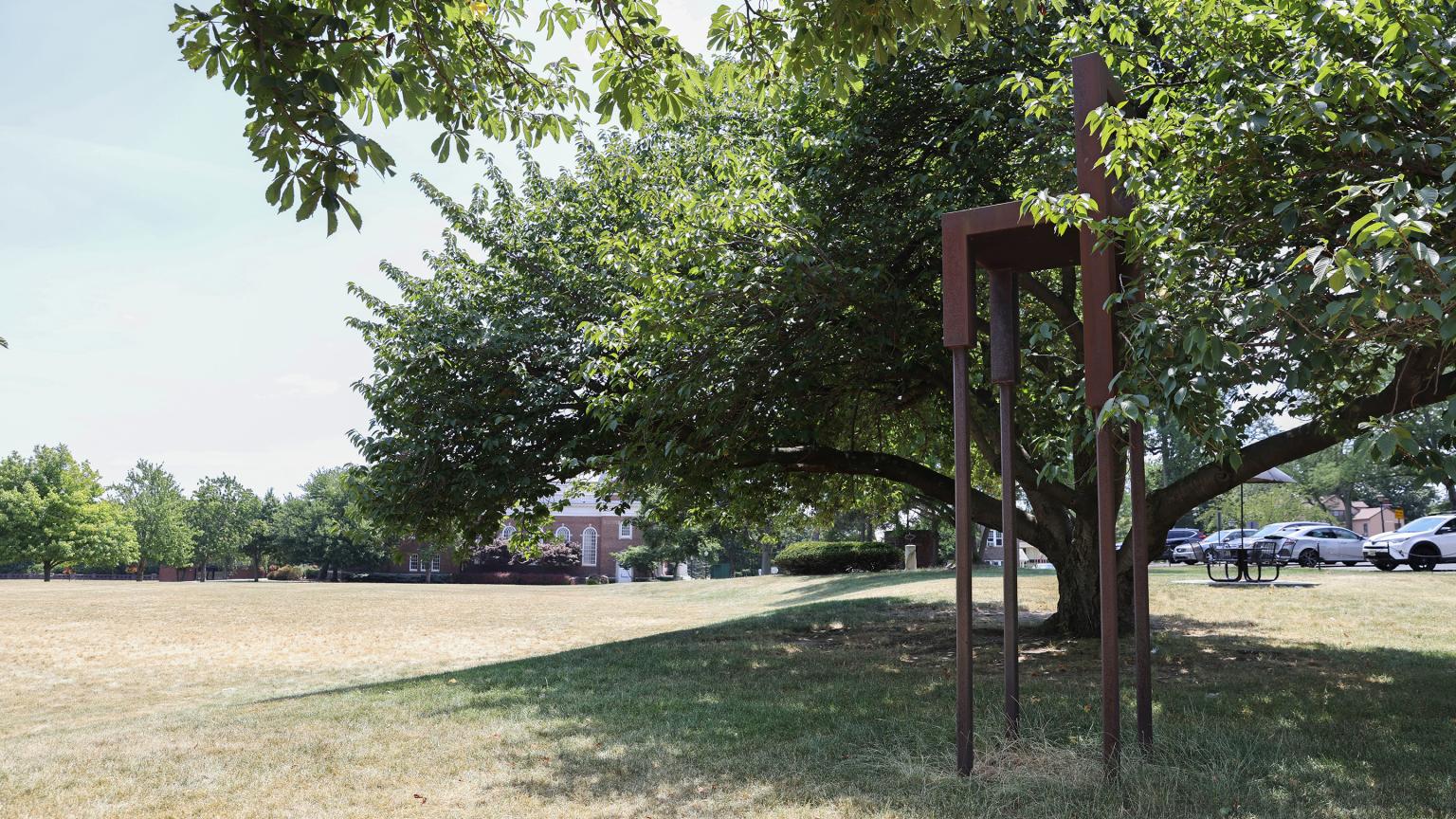
Sundial (1927) by Paul Rudin
Located outside of College Hall, this structure having the inscription, ““With them the seed / of wisdom did I sow / and with mine own / hand wrought to / make it grow / Class of 1927 AD” from Rubáiyát of Omar Khayyám by Edward FitzGerald, is etched along the sides of the hexagonal base. This sculpture contains a small figure crouched on the cylindrical base. Directions pertaining to north, south, east, and west surround this statuette. This is the oldest outdoor sculpture at Rutgers.
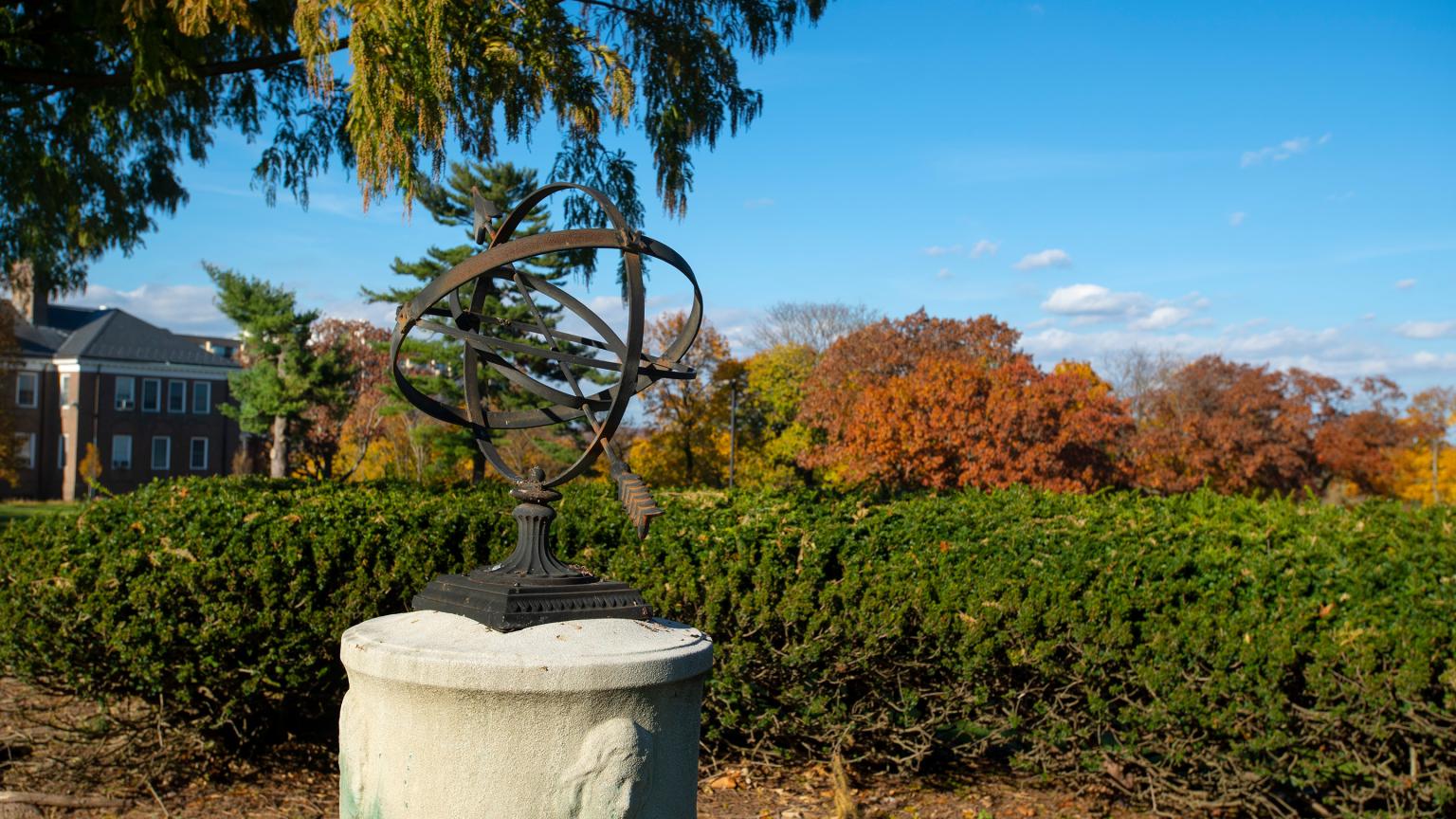
Brick Dome (1973) by (Vera) Jackie Winsor
Located in front of the Mabel Smith Douglass Library, there is the Brick Dome which is constructed of bricks protruding in concentric circles. The artist, Jackie Winsor is a 1967 Mason Gross School of the Arts graduate.
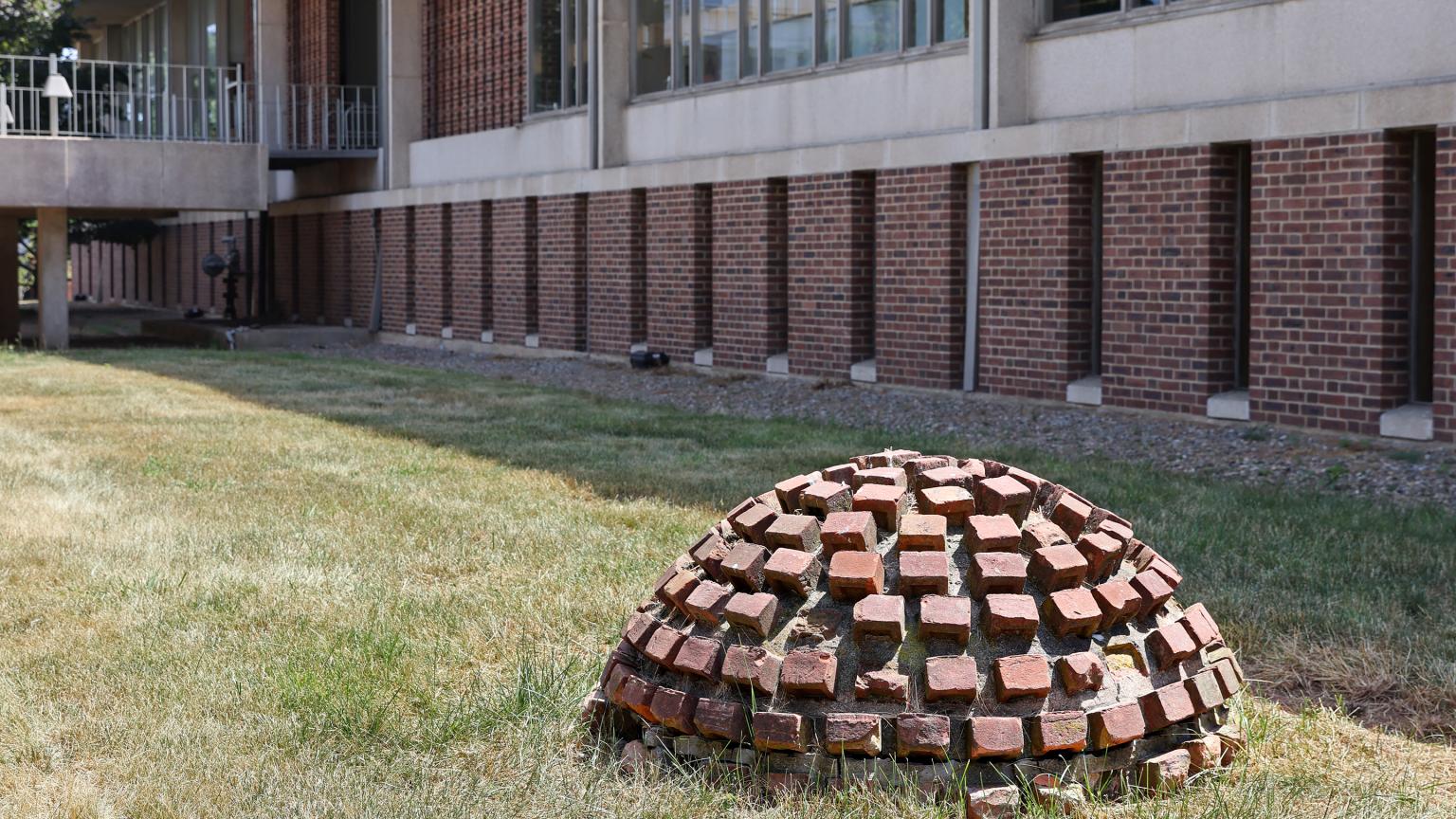
Players (1981) by Steven Feren
The artist, Steven Feren, a 1981 graduate of the Mason Gross School of the Arts, created Players as a part of his M.F.A. thesis. Rutgers later purchased 10 of the original figures. With the direction of the artist these figures were positioned in a small field outside the Art History Hall. This piece is located outside of Blanche & Irving Laurie Music Library
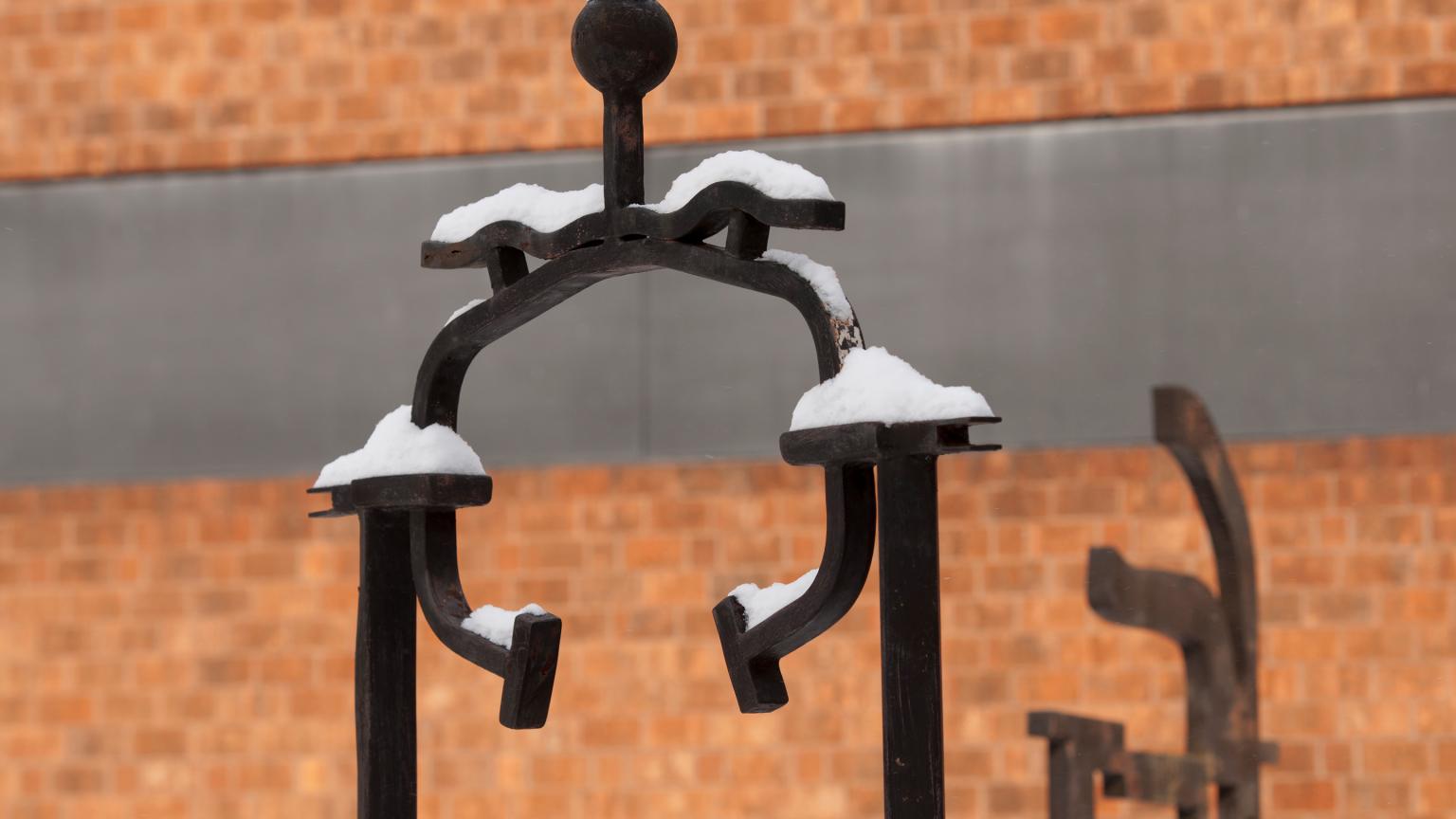
The Miraculating Machine in the Garden (1982) by Alice Aycock
Alice Aycock, the artist was a Douglass College graduate, Class of 1968, created this sculpture for the 10th anniversary of the college’s Mary H. Dana Women Artists Series. This work used neon, painted plexiglass, cyclotron pipe, and other modern-day materials to construct a sculpture full of anticipation and potential for motion. This piece is located in between Blanche & Irving Laurie Music Library and Voorhees Chapel.
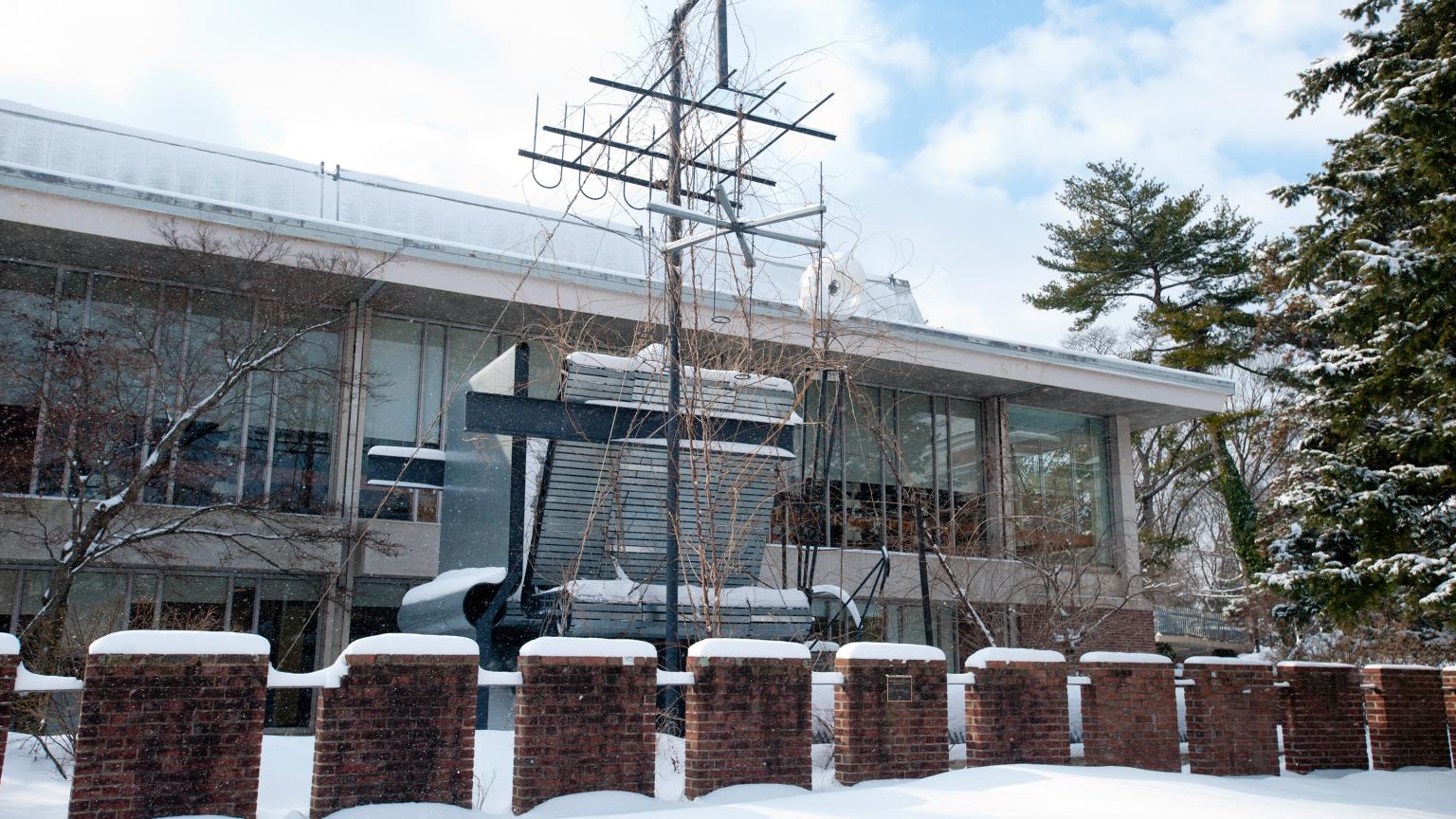
The Four Arts (2002) by John Goodyear
This sculpture, donated by the Class of 1952, is located on Bettenbender Plaza. Mason Gross dean George B. Stauffer noted that the area would “unite” the four major art departments of the Mason Gross School of the Arts: theater, music, dance, and the visual arts. Vertical steel bars create a modern four-sided column that serves as the basic structure for the sculpture.
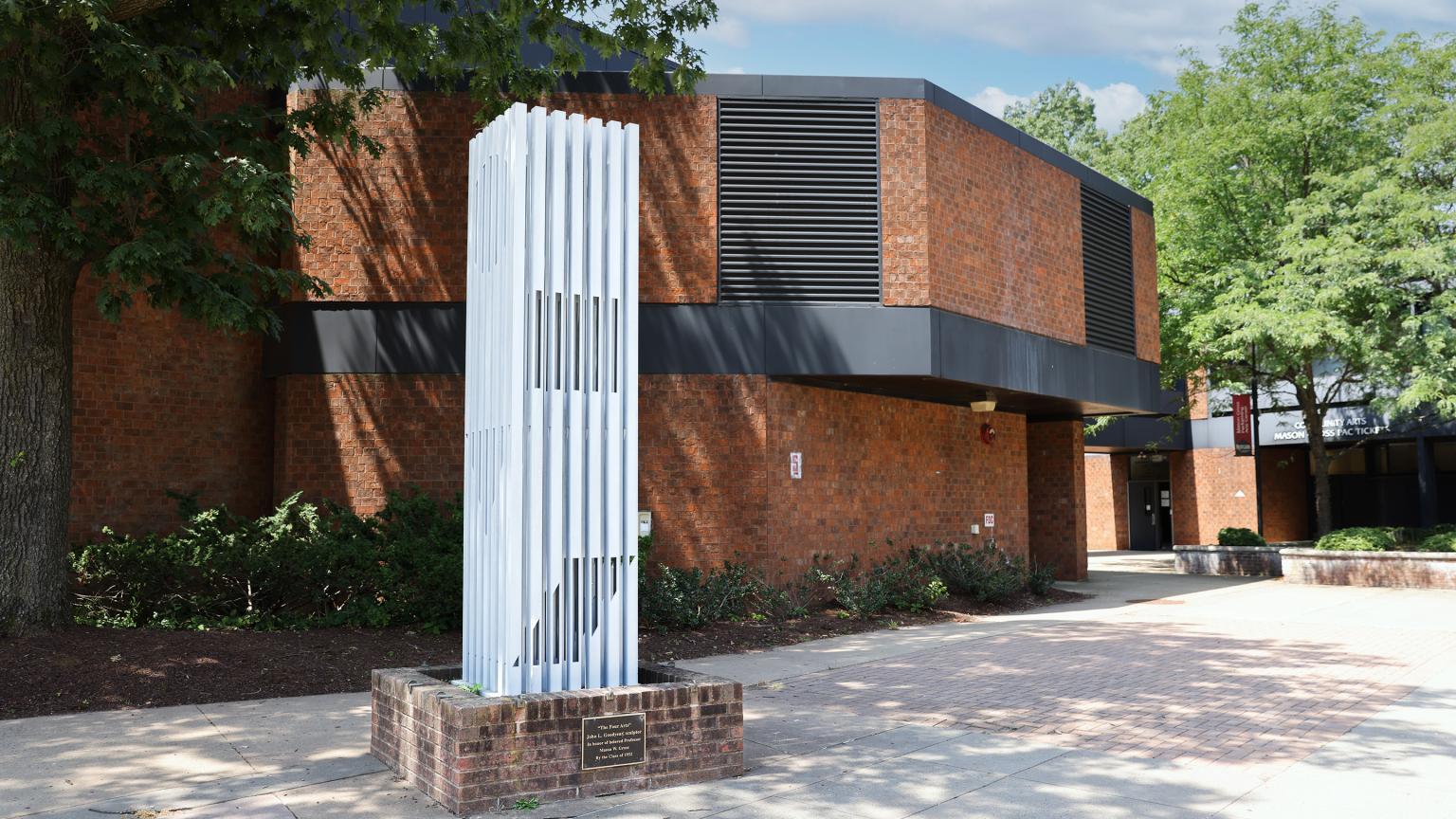
Spiral Field (1993) by Charles Fahlen
Surrounded by the Foran Stewardship Courtyard, this sculpture doubles as a piece of landscape architecture. This spiral invites students to enter the dome from the stone walkway to the entrance of the cage-like steel structure from which the path continues to spiral into a rounded wooden bench.
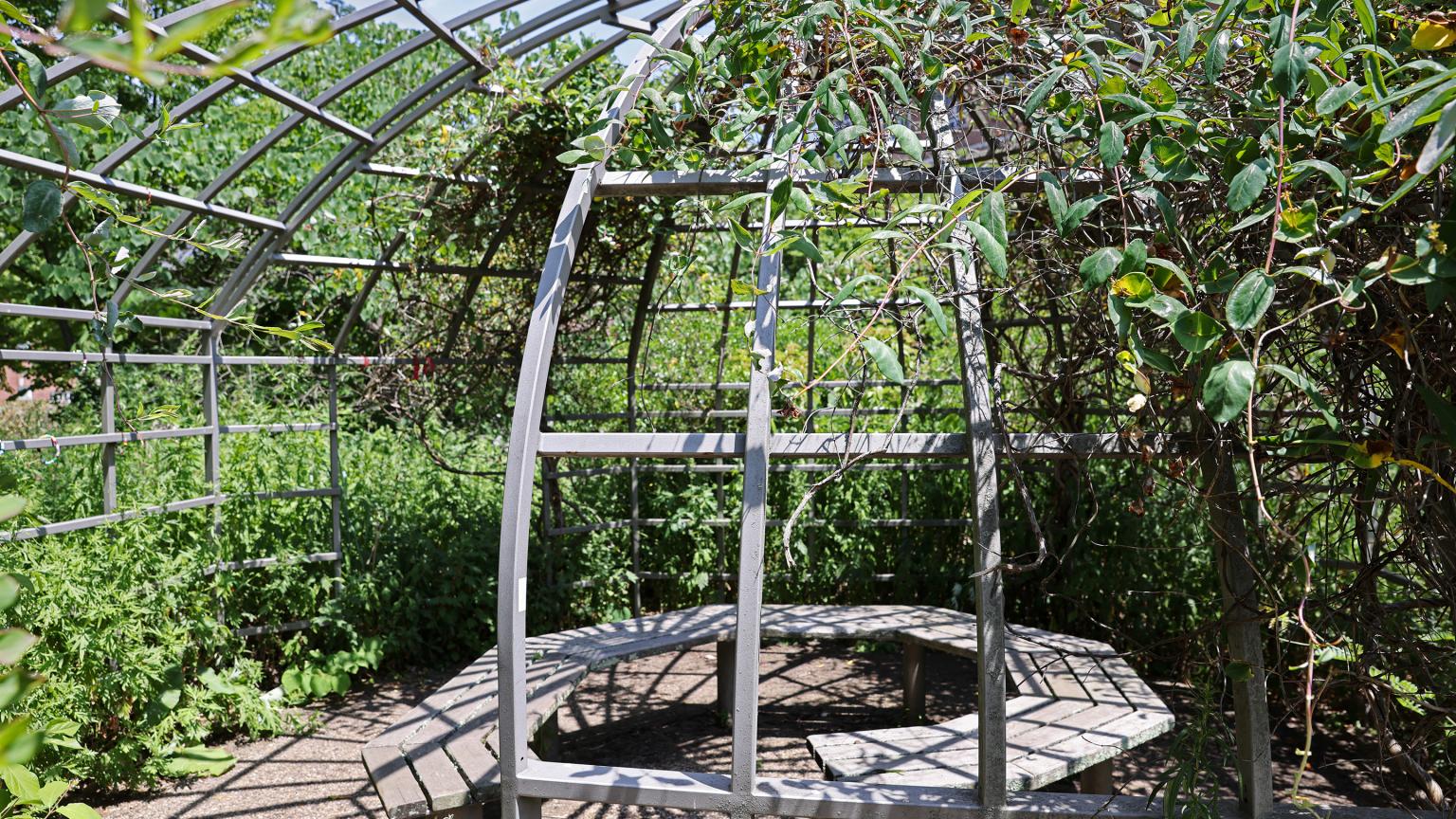
Current (1994) by Clyde Lynds
This sculpture resides in front of the Marine Sciences Building. Famous for his extensive work with fiber optics, sculptor Clyde Lynds created Current specifically to emphasize the function of the institute. Current comes to life at night when Lynds’s use of multicolored discs and fiber optics creates a continuously differing display of marine organisms that cycles over two days.
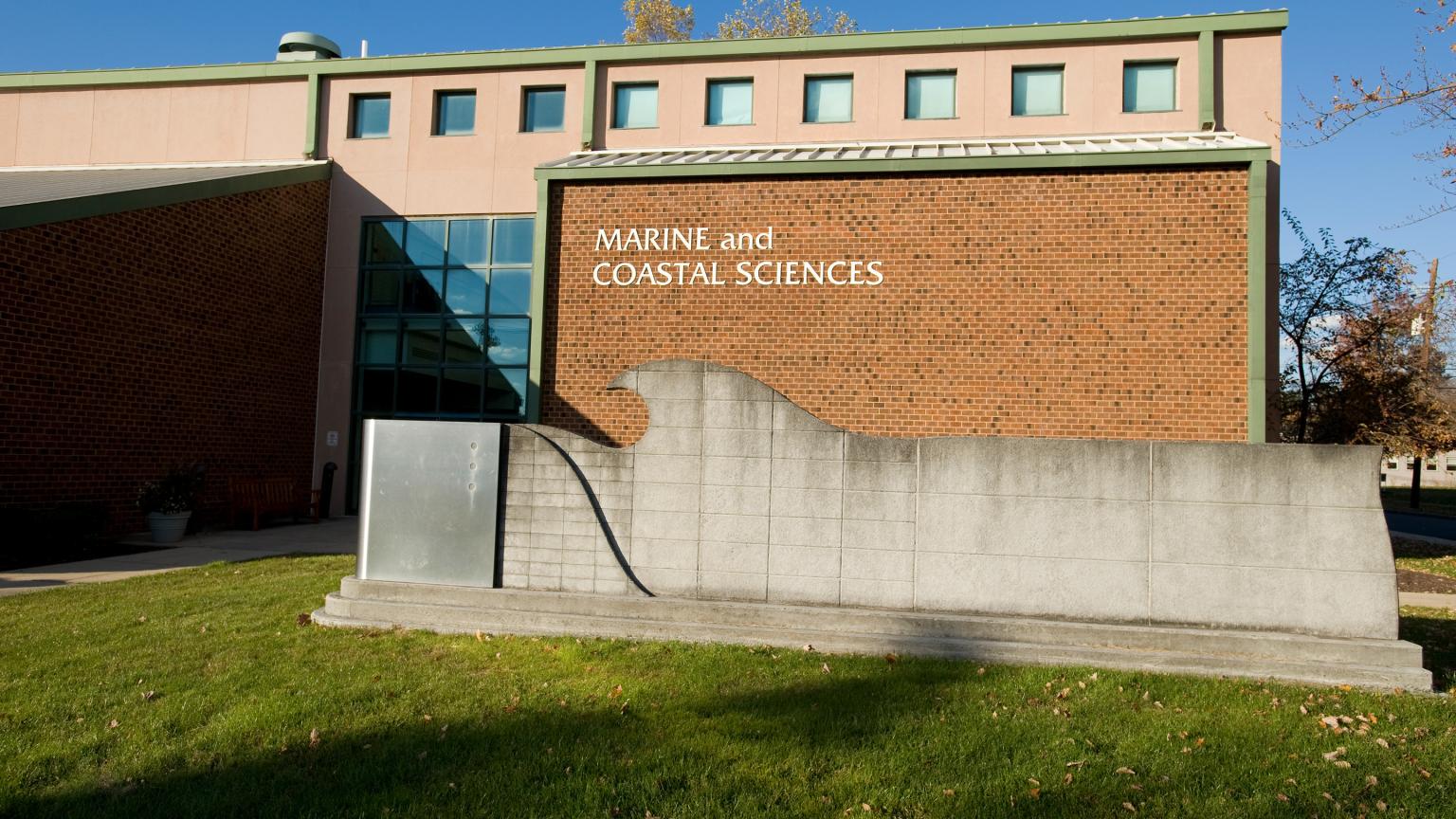
Rising (1988) by Scott Ernst
The artist, Scott Ernst, a 1985 graduate of Rutgers designed this piece. This area serves as a gathering space for students. An image of a boldly colored winged creature occupies the outdoor floor space. This piece is located outside the Cook Student Center.
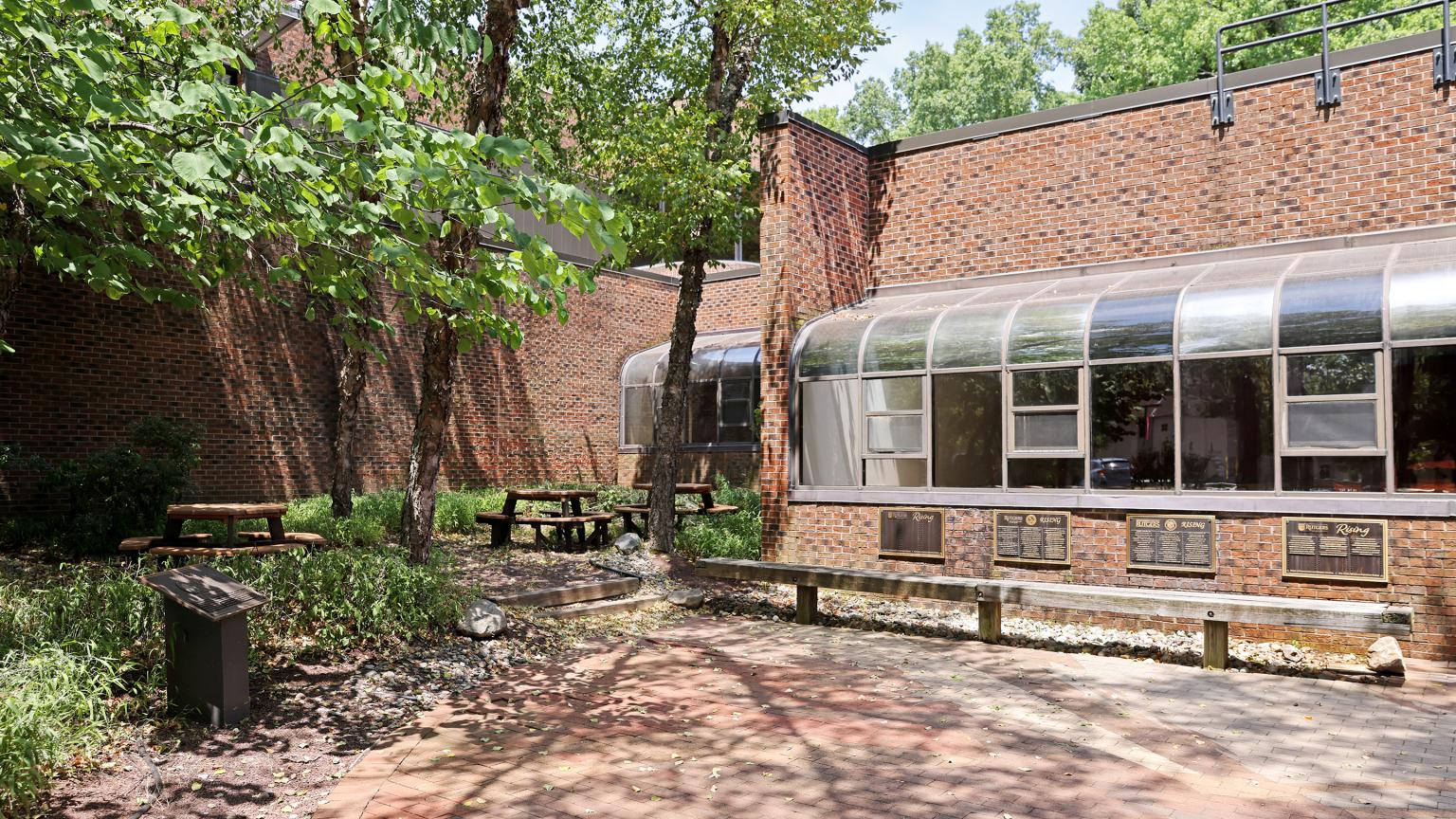
Livingston Campus Sculpture Tour
The expansive Livingston Campus, the youngest and largest of Rutgers–New Brunswick’s campuses, is home to many first-year students. The sculpture found here expresses a forward-looking personality, an academic feel, and a delightful eccentricity.
Education Is an Open Book (1987) by Melvin Edwards
This creation by Melvin Edwards, a former professor at Rutgers, stands outside the Kilmer Library. Edwards’s book, which is displayed to the viewer on a pedestal of geometric shapes, is a reminder of the presence and importance of learning.
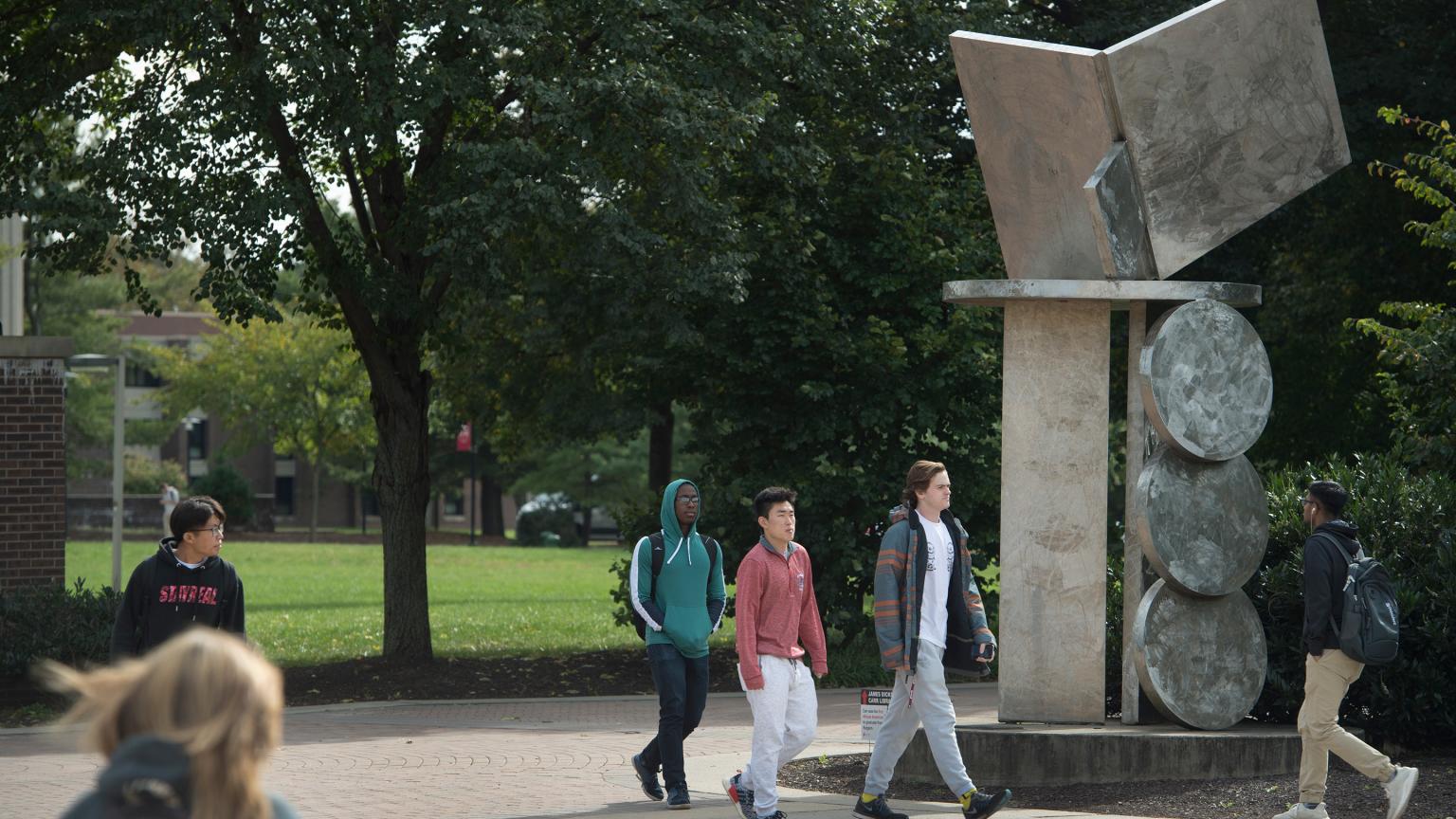
Don Quixote with a Flower (1976) by Nikolai Silis
Located outside of Kilmer Area Library/Media Center, this creation is made by Russian sculptor Nikolai Silis, whose past works appeared in Soviet era buildings. In this work, Don Quixote sits in a relaxed position, legs and arms bent, as he examines a flower. This is correlated with Cervantes’s novel in which Don Quixote is referred to as the “flower of knights-errant.”
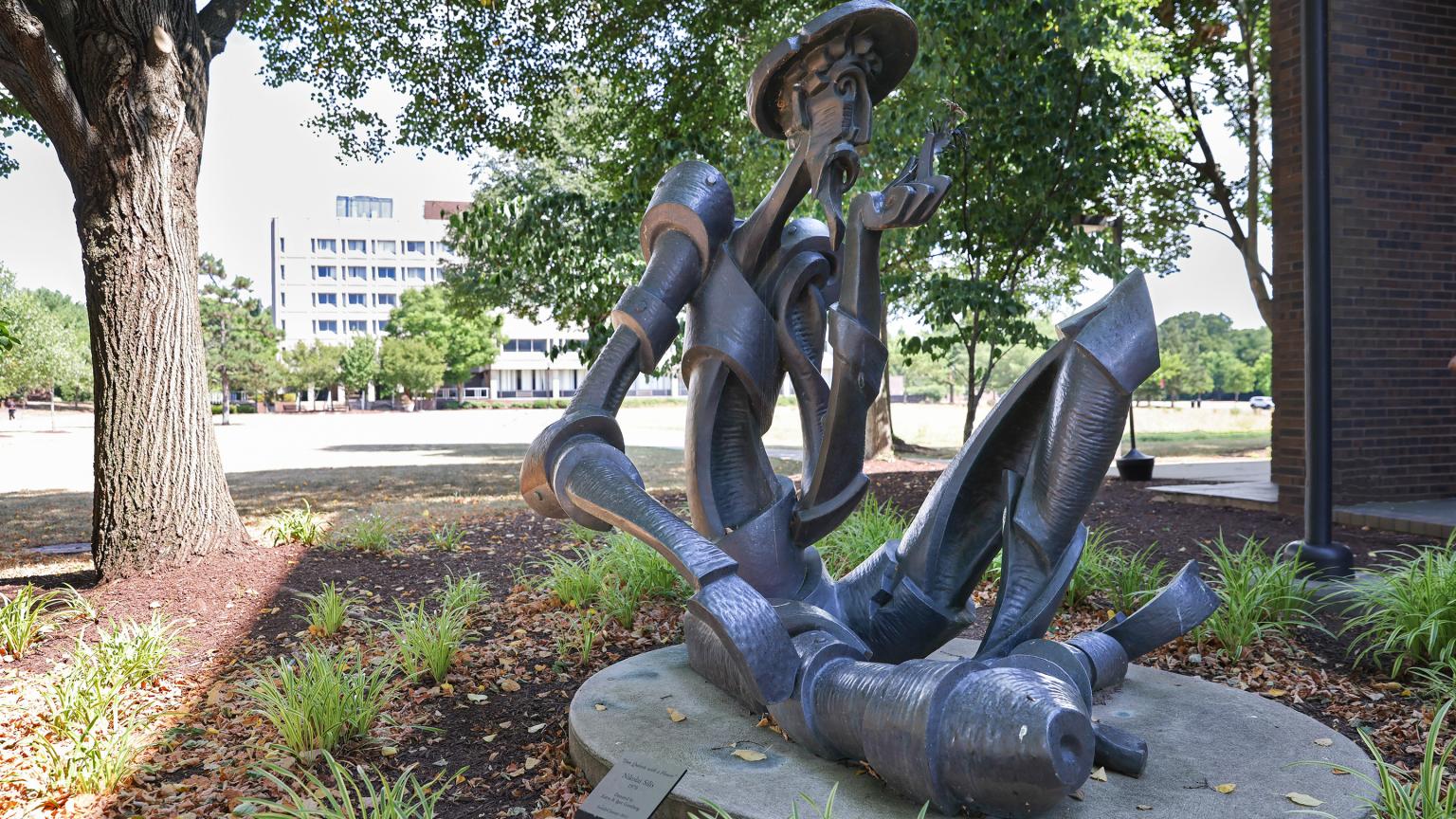
Calligraph KC III (1968) by Herbert Ferber
This structure once resided on College Avenue, in between Brower Commons and Stonier; it has now been moved to Livingston Campus outside of A Wing and Tillett Hall after restoration. This abstract piece may appear to simply be a configuration of flattened and curved copper pieces, however, they create the image of “K” and “C” in midair.
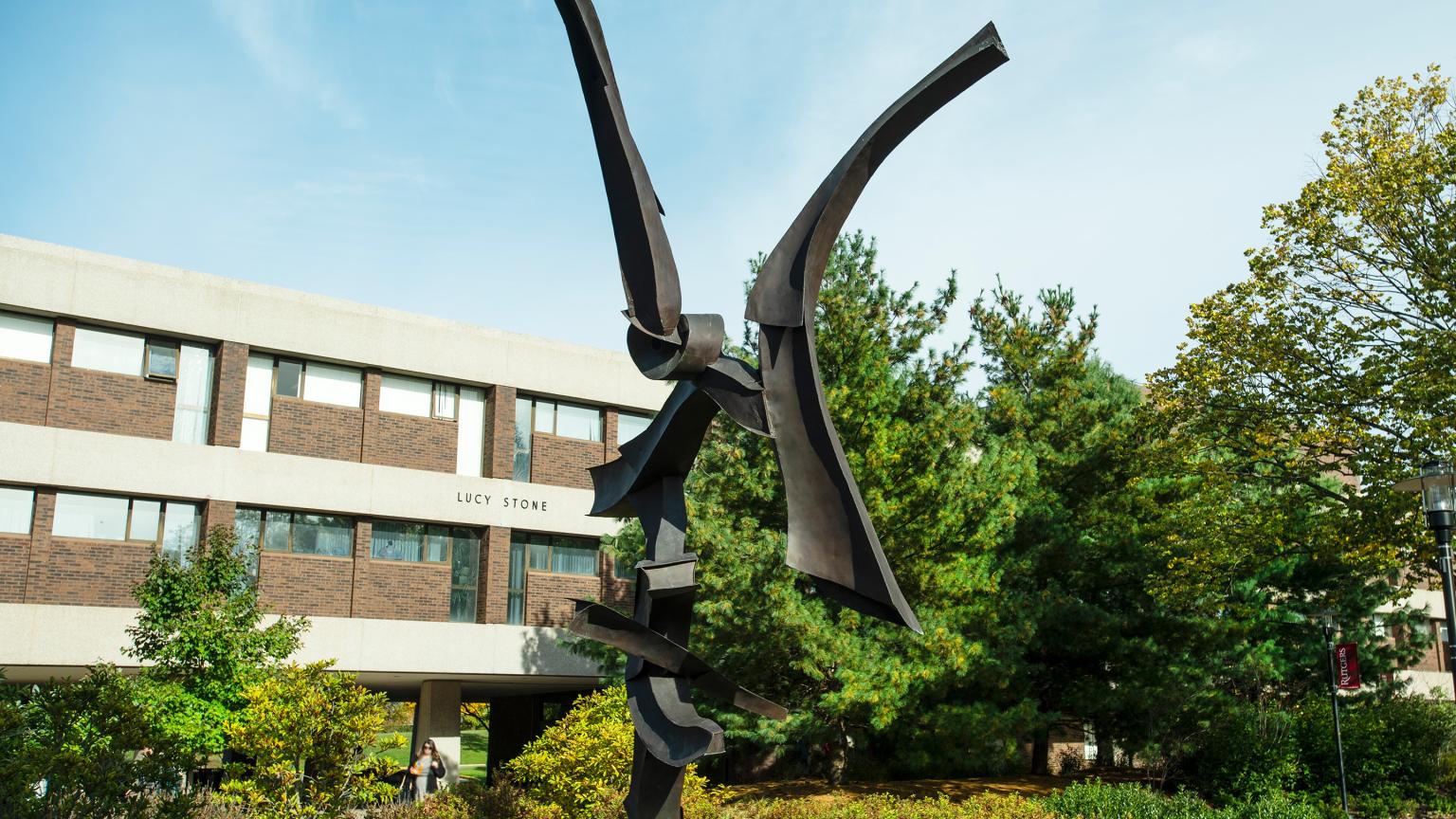
Zhu’s Helper (2012) by Gary Kuehn
Located outside the Visual Arts Building, this piece created by Rutgers professor Gary Kuehn, was built by four undergraduate visual art students in the Mason Gross School of Arts. This work is a nod to Zhu Rong, a god from Chinese mythology who is said to have seperated the sky and earth.
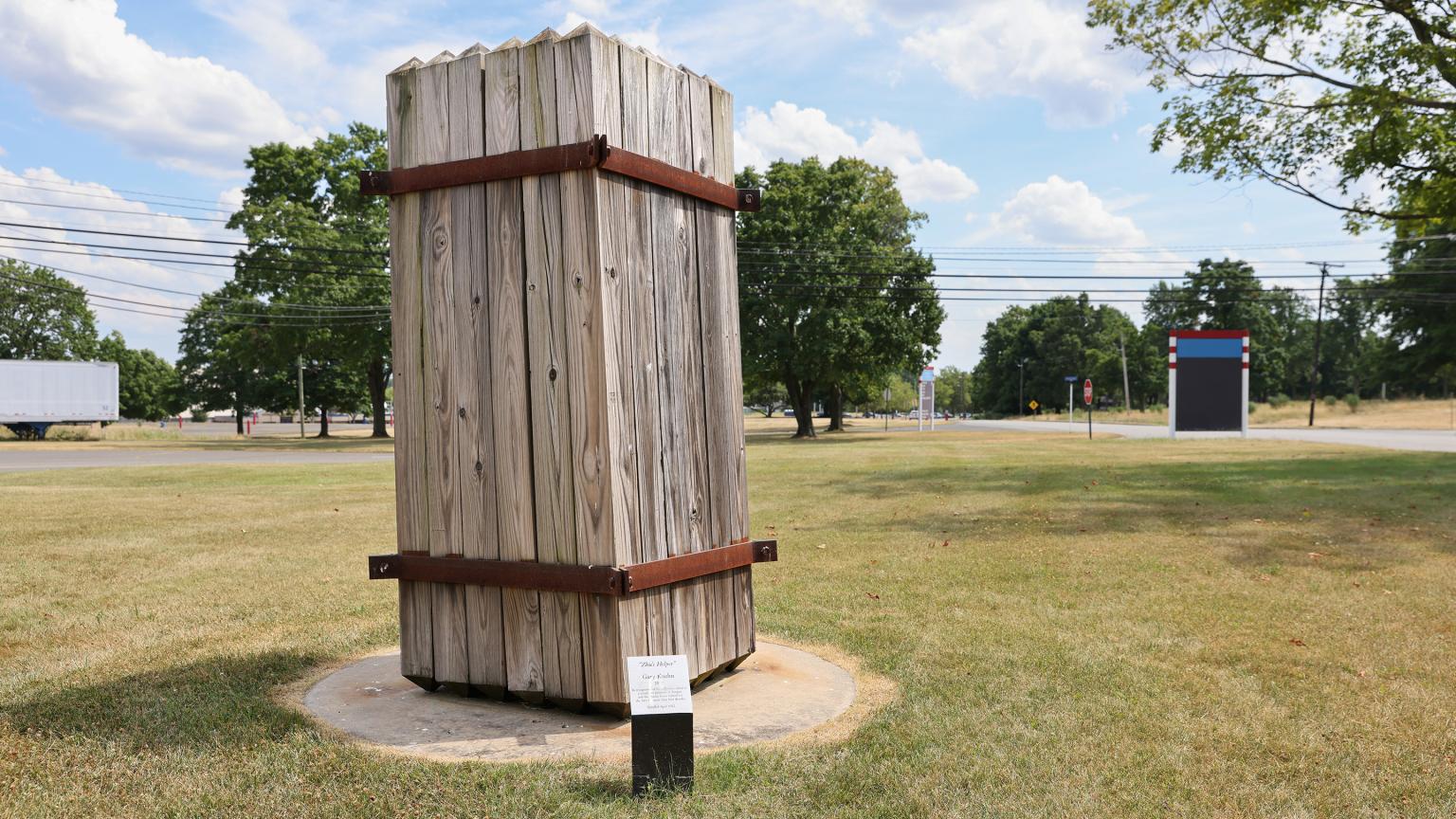
Untitled (1973) by “People’s Painters”
This mural is one of the earliest pieces that was created on Livingston Campus. These murals were painted by “People’s Painters” , a largely student-run group established in the 1970s. In keeping with Livingston College’s motto, “Strength through Diversity,” the mural celebrated Livingston College through its depiction of several intertwined figures representing people from different backgrounds. This work is located outside of the RUNet Field office.
